Lingyin Temple
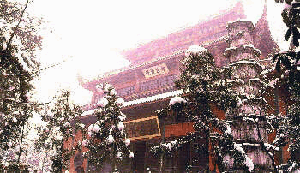
Lingyin Temple
Lotus in Breeze at Qu Garden
Lotus in Breeze at Qu Garden
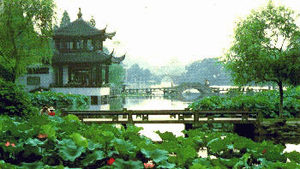
3 Pools Mirroring The Moon
3 Pools Mirroring The Moon
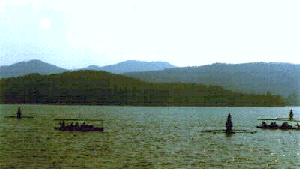
Mount Putuo
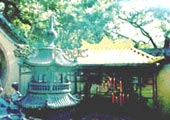 Mount Putuo (Putuoshan) is considered to be one of China’s four sacred Mountains and as such is yearly visited by reverent followers, all here to pay their respects to Guanyin, Goddess of Mercy. This is a great place to come, littered with temples and shrines, and, at a mere 12 square km, is easily navigated and covered in a few relaxing days. Even for those not coming on a Buddhist pilgrimage, the island provides a peaceful atmosphere and some of Chinese premiere beaches that even the most atheists will be impressed.
Mount Putuo (Putuoshan) is considered to be one of China’s four sacred Mountains and as such is yearly visited by reverent followers, all here to pay their respects to Guanyin, Goddess of Mercy. This is a great place to come, littered with temples and shrines, and, at a mere 12 square km, is easily navigated and covered in a few relaxing days. Even for those not coming on a Buddhist pilgrimage, the island provides a peaceful atmosphere and some of Chinese premiere beaches that even the most atheists will be impressed.
Besides the many temples, the island is also lush in vegetation and a profusion of forests, all flourishing in the warm and humid climate. Amidst such an environment, a stroll around the mountain or an immobile day at the beach is equally attractive.
On top of all this, Mount Putuo has some of China’s greatest seafood on offer. Sampling fresh seafood dishes has become an indispensable part of any trip to Putuoshan.
Despite the name, the trip to Mount Putuo does not involve any overly strenuous climbing. The highest peak here is a mere 300 meters above sea level and for most of the small peaks on the island cable cars are available (RMB30 for the round trip). Maps for the island can be brought for a small price beside the port. For those not wishing to track, the island also has a fairly comprehensive minibus transport system to all the main sights.
ATTRACTIONS:
The Thousand Step Beach and the Hundred Step Beach
Apart from the sacred Buddhist Mountain, the island of Putuo is known as a haven of blue sea, golden beachesand sun, ideal for a relaxing weekend. The island boasts a few excellent beaches on each of its corners, among these, the Thousand Steps Beach and the Hundred Steps Beach are the most famous and are regarded as the best beaches near Shanghai.
Both beaches lie along the coast on the eastern edge of the island, separated in the middle by a rocky hill (with the famous Chaoyang Pavilion on top), the best place to view the sunrise. The rocky hill also hides the famous Chaoyang cave (Chaoyang dong).
The sand of both beaches is fine, ideal for sunbathing. The facilities are also good, you can enjoy a leisurely afternoon of swimming and bathing without even leaving the beach for refreshment since restaurants and shops are adjacent to the beach. Various water sports activities can also be organized from here.
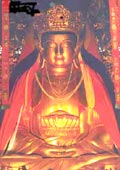 The Three Sacred Temples
The Three Sacred Temples
As a Buddhist shrine, Mount Putuo boasts a lot of Buddhist temples. Among them the three temples below are most important for their religious significance, historic value and the great Buddhist art they boast. Each of these temples has imposing architecture and a large collection of art pieces on religious themes.
Puji Temple: This is the main Temple for worshipping the Guanyin Buddha, the Goddess of Mercy. The temple boasts a mighty bronze Pilu Guanyin Statue with harmonious expression.
Fayu Temple: This temple is famous for its ancient architecture, delicate woodcarvings and inscribed calligraphy by ancient emperors.
Huiji Temple: This Temple is ideally located on the peak of Foding Hill, commanding a excellent view of the rising sun in the morning. The temple is famous for its large collection of ancient brick carvings portraying the Guanyin Buddha.
The Grand Guanyin Statue
The four Chinese Buddhist Mountains are each believed to be dominated by a major Buddha; Mount Putuo is regarded as the sacred mountain of Guanyin, the Goddess of Mercy, and so statues of Guanyin are a dominant theme here. In Chinese Buddhism, Guanyin has been popular among ordinary worshipers for the belief that the Buddha is able to save people from poverty.
On the Peak of Longwui hill stands a 33m statue of the grand Buddha, erected in 1997 in bronze and gold. Since the completion of this imposing statue, the Buddha has been visited and worshipped by millions of pilgrims annually. The statue itself is a great piece of art, visable by boat far from the island. Today, the statue has become one of Mount Putuo’s most symbolic sights.
Hangzhou
 Hangzhou’s fame rests mainly with the picturesque West Lake,so named because it is located on its western fringe. Covering about four square miles,West Lake is sur-rounded on three sides by rolling wooded hills.At the center are therr isles-Lesser Yingzhou,Midlake pavilion and Ruanggong Isle.
Hangzhou’s fame rests mainly with the picturesque West Lake,so named because it is located on its western fringe. Covering about four square miles,West Lake is sur-rounded on three sides by rolling wooded hills.At the center are therr isles-Lesser Yingzhou,Midlake pavilion and Ruanggong Isle.  Solitary Hill stands by itself on the northern lake shore.It can be reached from the city by Bai Cause-way,while Su Causeway bisects the lake from north to south.The blue,often rip-pling,water is dotted with elegant stone bridges and charming pavilions…
Solitary Hill stands by itself on the northern lake shore.It can be reached from the city by Bai Cause-way,while Su Causeway bisects the lake from north to south.The blue,often rip-pling,water is dotted with elegant stone bridges and charming pavilions…
Broken Bridge
Broken Bridge

More about Mount. Yandang
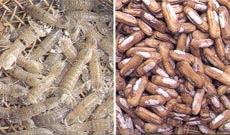 In talking about the Yandang Mountain tour, people would summarize in such a way: “It’s a real wonder in the world, and a remarkable beauty by the sea”. This, is no exageration at all. As one of among the first group of the National Scenic Zones declared by the State Council, Mt. Yandang is the very one that features a characteristic of both mountainious and maritime beauty.
In talking about the Yandang Mountain tour, people would summarize in such a way: “It’s a real wonder in the world, and a remarkable beauty by the sea”. This, is no exageration at all. As one of among the first group of the National Scenic Zones declared by the State Council, Mt. Yandang is the very one that features a characteristic of both mountainious and maritime beauty.
Born of the sea, carved, eroded, kissed by the sea, Mt. Yandang also intends to show her maritime tenderness at the Yueqing Bay.
And by the sea, you enjoy a lot of seafood. A rare “fragrant fish” produced at the river’s mouth, plus the Dragon-pool Green Tea, the Guanyin Bamboo, Jinxing Grass and Shanlegong (a small bird that sings soundly), are the “Five Treasures” of the Yandang Mountain. Besides, the wood-carving of Huangyang, the straw waving, the red-flesh apricot and the bottle-gourd pear, are all the famous local products.
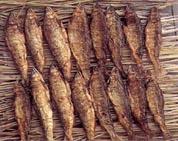 Due to its location of far-away and uneasy access, Mt. Yandang “has been survived to keep her nature of remote antiquity” (a remark by Fang Bao, a prose writer in the Qing Dynasty 1644-1911). But it was the case past. The airlines have reached Wenzhou for years; the Jinhua-Wenzhou Railway project has been recently fulfilled. Bridges span the rivers and huge ships paddle up and down the sea, and a high-way connecting Wenzhou and Taizhou will be soon accompIished. These modern transportations and communications will surely shorten the distance from Yandang to the outside world. Now, to reach Yandang becomes easy. Everyone of every nationality in the world, the old man and kids alike, would be welcomed at any time, to be a traveler or tourist to Mt. Yandang if he (she) would like to.
Due to its location of far-away and uneasy access, Mt. Yandang “has been survived to keep her nature of remote antiquity” (a remark by Fang Bao, a prose writer in the Qing Dynasty 1644-1911). But it was the case past. The airlines have reached Wenzhou for years; the Jinhua-Wenzhou Railway project has been recently fulfilled. Bridges span the rivers and huge ships paddle up and down the sea, and a high-way connecting Wenzhou and Taizhou will be soon accompIished. These modern transportations and communications will surely shorten the distance from Yandang to the outside world. Now, to reach Yandang becomes easy. Everyone of every nationality in the world, the old man and kids alike, would be welcomed at any time, to be a traveler or tourist to Mt. Yandang if he (she) would like to.
The accommodations are ready. There are an available number of hotels and motels there in the mountain’s reception center, a small town called Xianglintou. Either luxury, or standard, or the economic class rooms are suitable to meet the very need. The romantic scenes of the “single-beamed bridge” and “the humble hut”, has gone ever with the wind.
Maybe, one feels no longer lonely while here. It’s a pity? However, to be a great mountain, Yandang has enough enticements and her beauty will remain and last for long.
Mount. Yandang
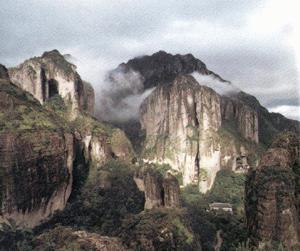 Fascinating as the landscape is in such a frame, the splendeur of the Yandang Mountain has been noticed since the Tang Dynasty (618-907). Located by the East China Sea and infused in a natural as well as cultural climate, the charisma of the mountain can by no means be framed in photos.
Fascinating as the landscape is in such a frame, the splendeur of the Yandang Mountain has been noticed since the Tang Dynasty (618-907). Located by the East China Sea and infused in a natural as well as cultural climate, the charisma of the mountain can by no means be framed in photos.
It’s immensely large– a large natural reserve named Mt. Yandang National Scenic Zone (Yandang literally means the wild goose and marsh). Situated in the southeast of Zhejiang Province, China, Mt. Yandang extends an area as large as 450 square kilometers. High rocks, fascinating caves, a good deal of waterfalls are specked everywhere in the zone thai defines the Chinese scroll painting.
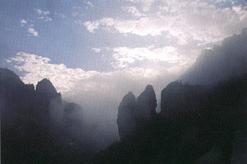 Large as it be to a many ancient travelers, such as Xu Xiake, a famous traveler-geographer in the Ming Dynasty(1368-1644) who paid three visits to Mt. Yandang in his life time. “l would have seen all the wonders in the mountain if I were a flying celestial.”
Large as it be to a many ancient travelers, such as Xu Xiake, a famous traveler-geographer in the Ming Dynasty(1368-1644) who paid three visits to Mt. Yandang in his life time. “l would have seen all the wonders in the mountain if I were a flying celestial.”
“The beauty is beyond description,” said a poet in the same way. “Yes, it denies words”, a prose writer could hardly disagree. However, it’s become the very reason to attract people to Mt. Yandang generation after generation.
The earliest visitor known to the Yandang Mountain was Xie Lingyun, a poet-governor of Yongjia Prefecture in the Southern Dynasties (385-433). As a matter of fact, he learned very little, if any, he had possibly seen only a small portion of the mountain.
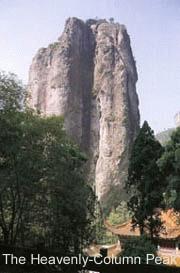 Yandang’s early reputation owes much to the following three men, or actually three monks in the Tang Dynasty (618-960). One was an Indian monk called Nuojuna, the founder of the first Buddhist temple in the area, who came settled here with his 300 disciples. The second was the well-known Master Yixing, who left behind with a painting of the mountain named “the Landscape And Its Two Borders”. And the third was Guan Xiu, a poet-monk whose poem depicting Mt. Yandang is still remembered. I reads: “Strolling along the path of the Yandang Mountain, I felt the peaks crowned with a misty gauze; while drinking tea by the side of the Dragon Waterfall, I myself was imbued in a drizzly cloud.”
Yandang’s early reputation owes much to the following three men, or actually three monks in the Tang Dynasty (618-960). One was an Indian monk called Nuojuna, the founder of the first Buddhist temple in the area, who came settled here with his 300 disciples. The second was the well-known Master Yixing, who left behind with a painting of the mountain named “the Landscape And Its Two Borders”. And the third was Guan Xiu, a poet-monk whose poem depicting Mt. Yandang is still remembered. I reads: “Strolling along the path of the Yandang Mountain, I felt the peaks crowned with a misty gauze; while drinking tea by the side of the Dragon Waterfall, I myself was imbued in a drizzly cloud.”
Mt. Yandang came to be widely known during the Song Dynasty (960-1279). Though it’s too late to be made famous as those of the Five Mountains in China, but it’s her fortune: being better preserved, and absolutely natural.
Well, we might have to feature it in some way if necessary: It’s magnificent with no lack of tender; it’s loosely simple but with no short of greenery; it’s deeply dense but also has broad views, and it appears steep and sharp where the very charming remains… Yet, whatsoever it should be, two words simply put by Shen Kuo(1031-1095), a Northern Song Dynasty scientist are mostly quoted: It’s “uniquely fascinating”.
Wenzhou – City of Commerce and Culture
Many people think of Wenzhou, whose many small commodities such as lighters, shoes and locks are well known the world over, as a commercial city. Shops line its streets, and Wenzhou people have such business acumen, they are popularly known as China’s prize wheeler dealers. On arrival, however, the traveler discovers that commercial as it may be, Wenzhou is nonetheless a city of high culture. The Nanxi River, Yandang Mountain and Jiangxin Island testify to this important city on the east coast of China’s long and illustrious history.
Nanxi River
The Nanxi River is in Yongjia County, 23 kilometers south of Wenzhou City. Covering 624 square kilometers, there are more than 800 scenic spots along its course, including ancient villages, rocks, mountains, primitive forests and waterfalls.
Wenzhou old town is the site of Neolithic cultural relics, and in the 200 or so old villages along the riverside are pagodas, bridges, streets, pavilions, archways and battlefields dating back to the Tang Dynasty. Ancient architectural facades are well preserved, as are the traditions, customs and life styles of the era in which they were built. Local inhabitants live one clan to a village, and enjoy a peaceful and happy life.
Cangpo is a Song Dynasty style village encircled by a moat where the Li clan lives. The village was designed in the style of the four treasures of study, namely the calligraphy brush, inkstick, inkslab and sheet of paper. A mountain to the right of the village resembles a brush rack, the brick road leading directly to the mountain a writing brush, and two square pools at the sides of the road could be ink wells. Beside them is a 5-meter-long stone slab — the inkslab — and the village’s enclosing wall is reminiscent of unfolding paper.
The Chen clan lives in Furong Village, whose streets and residences are interspersed with streams. First built in the late Tang Dynasty, 500 families, comprising over 2,000 people, now live in this village. Most of its houses are stone and wood structures with whitewashed walls and gray roofs, and trees grow tall in low-walled courtyards.
Wenzhou people have always attached equal importance to farming and commerce. The city’s commercial aspect is attributable to the northern imperial officials who fled there to escape wars in northern China when China was largely agricultural. Having made such early inroads into commerce, residents of Wenzhou made, and still have, a reputation for astuteness and economic know-how.
The unique landscape, culture and commerce of Wenzhou attract numerous domestic and overseas visitors from all social sectors. It has been nominated for a World Natural Heritage listing.
Yandang Mountain
Yandang Mountain on the northeast coast of Wenzhou is one of the ten most famous mountains in China. Named by the State Council as one of the first group of key Chinese scenic destinations, it is now in the process of applying for UNESCO World Natural Heritage status.
Yandang Mountain is regarded as the first mountain of Southeast China. Lakes, bulrushes and grasses adorn the mountain, and in autumn migrating geese stop here to rest. The mountain was formed some 120 million years ago, and is regarded by scientists as a natural museum of great historic and scientific significance.
Yandang Mountain is divided into scenic areas that comprise Spirit Peak, Spirit Crag, Dalong (Great Dragon) Pond, Sanzhe (Three Steps) Waterfall, Yan (Geese) Lake, Xiansheng (Victory) Gate, Yangjiao (Goat Horn) Cave and Xianqiao (Fairy Bridge) s.
The most famous peaks on Yandang Mountain are Zhuobi (Sharp Pen), Duxiu (Unique Beauty), Yunu (Jade Girl), Shuangluan (Two Fabulous Birds), Jinji (Golden Roosters) and Shuangsun (Double Bamboo Shoots). As their names indicate, the shapes of these peaks vividly resemble animals and other objects, and some change their look completely, according to the angle from which they are viewed. For example, Spirit Peak, one of the three most popular Yandang peaks, looks like two palms closed in prayer when viewed from the left, but at nightfall like a closely entwined couple, while from a different angle again, like an eagle poised for flight.
There are also many famous caves on Yandang Mountain. Among them are Guanyin Cave — the loftiest, Tianchuang Cave — the most perilous, the vast Xianren Cave, and the particularly grotesque Xiangu Cave. Guanyin Cave is on Spirit Peak, and used to be inhabited by eminent monks of the Tang Dynasty. The cave ceiling is 100 meters high and 40 meters across and it houses a nine-story pagoda. Through the entrance is Tianwang Hall, where stand statues of the four Buddhas’ warrior attendants. The 377 stone steps at the back of the hall lead up to Guanyin Hall, and monks live and study in the cave’s other rooms. The sound of bells ringing and drums being beaten every morning gives the mountain a profoundly spiritual ambience.
There are waterfalls on Yandang Mountain all year round, and the 190-meter high Great
Dragon Pond Waterfall is probably Yandang’s most famous scenic feature.
Jiangxin Island
Remote Jiangxin Island is to the north of Wenzhou City, and covers 70,000 square meters of land. The island has been famous throughout history, and its East and West pagodas were built in the Tang and Song dynasties respectively. Jiangxin Temple, which covers a floor space 3,000 square meters, also dates from the Tang Dynasty. There are altogether ten scenic spots on this small island that have been enjoyed since ancient times.
Tourism Information
For their first visit, visitorss are recommended sample some traditional and delicious Wenzhou snacks, such as dumpling soup, sesame seed cake and glutinous rice dumplings.
Rafting is the main feature of the Nanxi River tour. For 32 yuan, you can sit on a raft, and listen to the sound of rushing water as you gaze at the fantastic mountain scenery. The best time for rafting is late October, when the mountain forests are at their most colorful. This is an ideal place to relax and escape from the noise and bustle of the city.
Yandang Mountain offers local delicacies, like shark’s fin and dried shrimp, and exquisite handicrafts, such as carved wood, papercuts, and woven straw hats and baskets.
On Spirit Crag, folk acrobatics are performed at a height of more than 260 meters along a 256-meter-long tightrope between Tianzhu and Zhanqi Peaks. Performances are at 10:30 and 15:00 from Monday to Thursday, and at 10:30, 13:30 and 16:00 on Friday, Saturday and Sunday.
Wenzhou’s booming private economy attracts travelers interested in visiting some of the local enterprises. Several travel agencies now arrange economy exploration tours in Wenzhou and arrange lectures on the Wenzhou mode economy.
The Yandang Mountain
A Leisure Area with Wonderful Scenery
The Yandang Mountains are one of the ten famous mountain ranges in China, located in the coast northeast of Wenzhou City, Zhejiang Province. It is composed of North Yandang, Middle Yandang and South Yandang.
The mountains, the largest among the 44 key scenic resorts of the country, cover an area of 450 square kilometers. The mountain range was formed 120 million years ago, and belongs to a complete and typical rhyolitic palcovolcano dating from the Cretacceous Period of the Mesozoic Era, in the edge of the volcanic belt of Asia surrounding the Pacific Ocean. The belt is older than the Andes and the western part of the United States. From 1984 to 1986,almost 200 pieces of cultural relics of the New Stone Age were unearthed, including teeth, horns, and bones of ancient animals and polished stone implements, jade and bronze wares. As the result of textual research, they belong to the cultural type of “HeMu du-BaiXiang bin-Liangzhu”. In the 1930s , a German geologist brought this area to the world’s attention by describing the Yandang mountain as beautiful as the mountains of Switzerland.
The mountain range includes 500 scenic spots in seven major scenic areas, including Lingfeng, Lingyan, Dalingqiu, Yanhu, Xianshengshan, Xianqiao, and Yangjiao Cave. Of them, Lingfeng, Lingyan and Dalongqiu have the best scenery.
The first thing that attracts visitors’ attention is the curiously shaped peaks and rocks there. Lingfeng Peak is the east gate of the Yandang Mountains, occupying an area of 46 square kilometers. The night view of it is rich in hazy poetic flavor. Two curious caves, Guanyin Cave and Beidou Cave, are where people traveling must go. Guanling Cave is 113metres high, 14metres wide and 76metres deep. It is warm in winter and cool in summer. Within the cave is a nine-story structure.
Some 30roaring waterfalls and tinkling springs are other attractions of the area ,including Yongcui, Yanwei (swallow’s tail), Luodai, Xida and Sanzhe (three-step) waterfalls. Dalongqiu Waterfall with a sheer drop of 197 meters is the biggest. The water drops down directly like a dragon during spring and summer, and beads of water splash through the mist in autumn and winter.
The third attraction is the ancient karst caves . Most of them are located between two peaks or on cliff sides. There are said to be 66 awe-inspiring caves . Besides the Guanyin Cave, there are Xiangu Cave and Tianchuang (skylight) Cave, which is a cave seen from the bottom of it.
The fourth attraction is the 23 screen-like peaks in the mountain range. Some peaks guard narrow gorges; others overlap or stand face to face. Tourists can wander to the valley bottom to look up at the wonderful peaks and listen to the sound of waterfalls. There is a 200-metre-wide “gate” called Xianshengmen. Entering the gate is like entering the very heart of the mountains as you are surrounded by cliffs with waterfalls seemingly dropping down from the sky. There are also the Tiecheng, Lianyun and Pingxia rock cliffs.
The fifth attraction is the 18 ancient tempts. Lingyan Temple, which is located in the Lingyan Scenic Area, is the most famous. It was built in 979 in the Song Dynasty, whose emperors Taizong and Renzong visited it and left inscriptions. The temple also preserves 100 volumes of rare Buddhist scriptures. On both sides of the main gate of the temple are eight Chinese characters, reading “Famous mountains by the sea” and “The best scenery in the world,” carved in the Ming Dynasty.
So the Yandang Mountains can not only be ranked as part of the world’s natural heritage but also are of rich cultural history. It is historically called “the first mountains in the south-east” and favorably known as “the famous mountains out of the sea”.
Besides ,there are very famous dishes in Yandang Mountains: White Chicken Meat and Sweetfish, River Eel and Potatoes, Yandang Stone Frog, Stewed Hare, Meat and Potato, Beautiful Yellow Croaker, Bean-curd and Surf Clam Soup, and Green Spinach and Shelled Shrimps, and Steamed Sea Crabs. Most of the ingredients are local products.
White Chicken Meat and Sweetfish is colorful and rich in nutrition. River Eel and Potatoes is made from locally-caught potatoes, and red and white turnips. Yandang Stone Frog is fine, tender and delicious. Beautiful Yellow Croaker is made of yellow croaker and a variety of vegetables. Bean-curd and Surf Clam Soup is a rare delicacy.
Hotels:
Chaoyang Mountain Village is the three-star tourist hotel in the Yandang Mountains. It is located at 56 Chaoyang Road, Yandang Mountains, Wenzhou. Its standard guestrooms are 320 yuan per person, and the price of its luxury suites is 1500 yuan. For bookings, telephone:(0577)2243484 or (0577)2243483.Fax:(0577)2243463
Yandangshan Mountains Village is on Xiaoxia Road , in the center of the scenic area. It is a garden-like hotel. Its standard guestroom is 420 yuan per person ,and the price of its luxury suite is 2800 yuan. For bookings, telephone:(0577)2241666
Yinhe Mountains Villages on Jingming Road, Yandangshan Mountains, Wenzhou. Its standard guestrooms 228yuan per person and the price of a standard suite is 588 yuan. For bookings, telephone:(0577)2241800
Travel:
It is 80 kilometers from Wenzhou Airport to the Yandang Mountains. From the airport there are flights to all the major cities in the country. It is 70 kilometers from Wenzhou Railway Station to the mountains. Trains connect Wenzhou with all the major cities in China,and buses connect it with neighboring cities including Shanghai, Ningbo and Hangzhou. There are also long-distance buses which go directly from Beijing to Wenzhou.
Ships go from Wenzhou Harbor to coastal cities, including Shanghai, Guangzhou, Xiamen and Hong Kong.
Agency
Yandangshan Mountains Travel Agency
It is managed by the Yandangshan Mountains Travel Bureau and it is the largest agency that can give service to the travelers at home and abroad .
Manager: Chenhongfang TEL: 0577-2243087 FAX: 0577-2243087
address: 6 the Lingtou Walk Street, Yandanshan
Hangzhou Tourism Resources
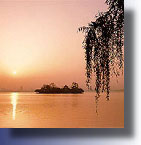 Hangzhou is extremely rich in tourism resources. Its unique environment endowed by nature and the culture accumulation of several thousand years, have formed many world famous natural, historical and cultural sights. There are two State-level scenic areas within the city area: West Lake scenery area and Fuchun river-Xin’an river – A-Thousand-Islet Lake scenery area. There is one State-level nature preservation area: Tianmu natural preservation area, two State-level forest parks: A-Thousand-Islet forest park and Daqishan forest park. These places are a galaxy of famous sightseeing tourism areas on the southeast China. West Lake, which is described as “Oriental Pearl “, is located on the east of the city proper, surrounded on three sides by hills and one side facing the city. Hangzhou, with its surrounding hills and numerous beautiful sightseeing places and the famous West Lake, ranking as one of the ten best famous scenic places in china.
Hangzhou is extremely rich in tourism resources. Its unique environment endowed by nature and the culture accumulation of several thousand years, have formed many world famous natural, historical and cultural sights. There are two State-level scenic areas within the city area: West Lake scenery area and Fuchun river-Xin’an river – A-Thousand-Islet Lake scenery area. There is one State-level nature preservation area: Tianmu natural preservation area, two State-level forest parks: A-Thousand-Islet forest park and Daqishan forest park. These places are a galaxy of famous sightseeing tourism areas on the southeast China. West Lake, which is described as “Oriental Pearl “, is located on the east of the city proper, surrounded on three sides by hills and one side facing the city. Hangzhou, with its surrounding hills and numerous beautiful sightseeing places and the famous West Lake, ranking as one of the ten best famous scenic places in china.
 The West Lake scenery area covers an 60 square meters, blending the famous scenery, historical and cultural sites, and hills and lakes as a whole. The “double ten scenic spots” add radiance and beauty to each another. In the scenery area, there are 5 places under the State Protection as the Cultural Relics, 25 places under provincial level protection, 30 places under municipal level protection. In the 1990s, Hangzhou have built many museums representing the Chinese culture: e.g : China Silk Museum, China Tea Museum, Hu Qinyu Tang Traditional Chinese Medicine Museum, Southern Song Porcelain Museum, Zhang Xiaoquan Scissors Museum, Liangzhu Culture Museum,etc. The places like Linyin Temple, Yue Fei Temple, Six Harmonies Pogoda, Huagang Park and the Running Tiger Spring are world-famous scenic and historical sites. The Qiantang Tidal Bore is the famous sight for viewing seasonal tide waves, which can be equaled to the sight of Amazon River. The Qiantang Tidal Bore has a history of more than several thousands years, and people’s enthusiasm for it never dies away. Those sights which are developed in recent years such as “Song Dynasty City”,”Future World”,”Children’s Park”,”The Square of Tai Temple Ruins “and ” Wushan Scenic and Cultural Area” which will be opened in the near future are becoming hot scenic spots for tourists. The total number of foreign tourists received in Hangzhou is five hundred and four thousand three hundred person/times, domestic tourists 21 million person/times.
The West Lake scenery area covers an 60 square meters, blending the famous scenery, historical and cultural sites, and hills and lakes as a whole. The “double ten scenic spots” add radiance and beauty to each another. In the scenery area, there are 5 places under the State Protection as the Cultural Relics, 25 places under provincial level protection, 30 places under municipal level protection. In the 1990s, Hangzhou have built many museums representing the Chinese culture: e.g : China Silk Museum, China Tea Museum, Hu Qinyu Tang Traditional Chinese Medicine Museum, Southern Song Porcelain Museum, Zhang Xiaoquan Scissors Museum, Liangzhu Culture Museum,etc. The places like Linyin Temple, Yue Fei Temple, Six Harmonies Pogoda, Huagang Park and the Running Tiger Spring are world-famous scenic and historical sites. The Qiantang Tidal Bore is the famous sight for viewing seasonal tide waves, which can be equaled to the sight of Amazon River. The Qiantang Tidal Bore has a history of more than several thousands years, and people’s enthusiasm for it never dies away. Those sights which are developed in recent years such as “Song Dynasty City”,”Future World”,”Children’s Park”,”The Square of Tai Temple Ruins “and ” Wushan Scenic and Cultural Area” which will be opened in the near future are becoming hot scenic spots for tourists. The total number of foreign tourists received in Hangzhou is five hundred and four thousand three hundred person/times, domestic tourists 21 million person/times.
 In order to lay a better foundation to build Hangzhou into an international tourism city, Hangzhou city has set up a green land system, and the system of public facilities street sight, which will be harmonious with the various scenic spots and at the same time maintain its own specific styles, which will become new tourism resources and will be one beautiful view by itself. By the way of making the conferences (exhibitions) tourism as the main guidance, devoting major efforts to develop various tourist products, perfecting international and domestic exhibition facilities, establishing many-levels tourism and vocational net work, let Hangzhou become the important tourism and vocational resort in the east of China which could serve the Yangtze Delta and open to the domestic and international market .
In order to lay a better foundation to build Hangzhou into an international tourism city, Hangzhou city has set up a green land system, and the system of public facilities street sight, which will be harmonious with the various scenic spots and at the same time maintain its own specific styles, which will become new tourism resources and will be one beautiful view by itself. By the way of making the conferences (exhibitions) tourism as the main guidance, devoting major efforts to develop various tourist products, perfecting international and domestic exhibition facilities, establishing many-levels tourism and vocational net work, let Hangzhou become the important tourism and vocational resort in the east of China which could serve the Yangtze Delta and open to the domestic and international market .
Dianchi Lake
 Dianchi Lake, also known as Kunming Lake, lies at the foot of Xishan Hills. It was formed by a fault on the central Yunnan Plateau and receives more than 20 streams.
Dianchi Lake, also known as Kunming Lake, lies at the foot of Xishan Hills. It was formed by a fault on the central Yunnan Plateau and receives more than 20 streams.
Xishuangbanna
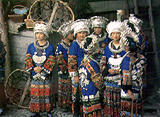 Xishuangbanna Dai Auto-nomous Prefecture is located in the southern part of Yunnan Province, over 500 kilometres from Kun-ming, the provincial capital and covering an area of 25,000 square kilometres. It is bounded on the south by Laos and Burma, with River Lancang running through the whole region.
Xishuangbanna Dai Auto-nomous Prefecture is located in the southern part of Yunnan Province, over 500 kilometres from Kun-ming, the provincial capital and covering an area of 25,000 square kilometres. It is bounded on the south by Laos and Burma, with River Lancang running through the whole region.
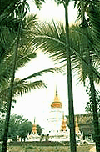 This autonomous prefecture has under its jurisdiedinnthres coun-ties :Jinghong, which is its capital, Mengla andMedghai .Yuhjing-hong, the county seat of Jinghong, means in the Dai language .”a city at dawn”. It is now open to foreign tourists as an excursion centre. The whole region has a temperate and moist climate, fit for the growth of all kinds of vegetation. This wooded country of exotic trees and flowers is the haunt of rare birds and animals-a para-dise in which all living beings thrive and flou-rish.
This autonomous prefecture has under its jurisdiedinnthres coun-ties :Jinghong, which is its capital, Mengla andMedghai .Yuhjing-hong, the county seat of Jinghong, means in the Dai language .”a city at dawn”. It is now open to foreign tourists as an excursion centre. The whole region has a temperate and moist climate, fit for the growth of all kinds of vegetation. This wooded country of exotic trees and flowers is the haunt of rare birds and animals-a para-dise in which all living beings thrive and flou-rish.
Xishuangbanna is a multinational prefecture. Of its population of 600,000one third are Dais, the rest being Hanis, Hans, Blangs, Lahus, Yaos, Was, Miaos, Jinos, Yis and others.
Kunming
 Kunming, the capital of Yunnan Province, is situated 1,895 metres above sea level on the Yunnan-Guizhou Plateau in southwest China. Rimmed by mountains on three sides with Dianchi Lake to the south, this beautiful city and its outskirts cover an area of 6,500 square kilo-metres. It has a population of 1.93 million, of 12 different nationalities including Han, Hui, Yi, Bai, Miao, and Hani. More than 2,000 years old, Kunming is now the political, economic, and cultural centre of the province.
Kunming, the capital of Yunnan Province, is situated 1,895 metres above sea level on the Yunnan-Guizhou Plateau in southwest China. Rimmed by mountains on three sides with Dianchi Lake to the south, this beautiful city and its outskirts cover an area of 6,500 square kilo-metres. It has a population of 1.93 million, of 12 different nationalities including Han, Hui, Yi, Bai, Miao, and Hani. More than 2,000 years old, Kunming is now the political, economic, and cultural centre of the province.
 The climate in Kunming is mild. In spring (February, March, and April) and autumn (August, September, and October), a wool sweater is recommended. The city has a cool summer and, while a shirt is enough for the day, a jacket is needed in early morning and evening. Elderly tourists should bring wool vests or wool sweaters. Rain gear is needed during this season. Winter is seldom cold in Kunming. However, tourists are advised to bring wool or heavy clothes or jackets.
The climate in Kunming is mild. In spring (February, March, and April) and autumn (August, September, and October), a wool sweater is recommended. The city has a cool summer and, while a shirt is enough for the day, a jacket is needed in early morning and evening. Elderly tourists should bring wool vests or wool sweaters. Rain gear is needed during this season. Winter is seldom cold in Kunming. However, tourists are advised to bring wool or heavy clothes or jackets.
Da Li
Da Li is situated between Dian Cang Mountain and Er Hai Lake. The western Dian Cang Mountain meanders its way southward, with a total length of 45 kilometers. the eastern Er Hai Lake is a freshwater lake in the south-west plateau of our country, with an altitude of l,972 meters. Between Dian Cang Mountain and Er Hai Lake are 18 brooks linking up southwards and westwards, a crisscrossing river network and fertile ground and exist rich produce and lovely scenes. As early as 3000 years ago, Bai nationality resided here. 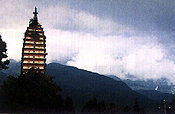 And dur ing the periods of Tang and Song Dynasties, Da Li was once the political, economic and cultural center of Yun Nan. So many ocenic spots and historical sites left over from history, such as the ruins of ancient battlefield with shining spears and armored horses, the Han (Dynasty) Southern Silk Road being renowned both at home and abroad Bo Nan OId Way, Buddhist Saint Ji Zu Mountain, Shi Bao Mountain titled as “SouthWest Dunhuang Grottes”, thus becoming a tourist attraction. Xiao Pu Tuo is the most richly spiritual scenic resort in Er Hai Lake with a cir cumference of 200 li, extremely like one graceful lmmortal lsland tloating over the gem blue sea surface. This island is formed by a gigantic reef soaring high out of Er Hai Lake, on which grow green pines and emerald bamboo and marble rails set Guanyin (a Boddhisattva) Pavilion off against flying gold and dazzling silver lights. Walking 20 li southwards from Xiao Pu Tuo, Luo Quan Temple on the top of Yu An Mountain, sets off among the blue sky and white clouds, and the green pines and incense cedars. Since built as early as in Tang Dynasty, it has been renovated several times. lts main buildings include Guangyin Palace and Sea View Pagoda. San Pagoda in Chong Sheng Temple is situated north-west of Da Li City and below Ying Le peak of Dian Cang Mountain. Facing Er Hai Lake, you can, several li away, overlook its profile towering into the clouds. San Pagoda was built up during the Nan Zhao Feng You Period (823-859AD) in Tang Dynasty. Tradition has it that in Tang Dynasty, two architectural craftsmen, Gong Tao and Wei Yi, were dispatched to Da Li to design this Pagoda according to the local topographical conditions and instructed in person the local people to build it up. It is a 16-storeyed square Pagoda with dense cavcs, 69. 1 3 meters in height. On ihe iop are metal Pagoda temple, sacred canopy, sacred crown and golden pheasant; on the four cor- ners are copper-cast greenfinches (accord- ing to legend,they were made by Bai dwell- ers to vanquish Er Hai demons and mon- sters.)
And dur ing the periods of Tang and Song Dynasties, Da Li was once the political, economic and cultural center of Yun Nan. So many ocenic spots and historical sites left over from history, such as the ruins of ancient battlefield with shining spears and armored horses, the Han (Dynasty) Southern Silk Road being renowned both at home and abroad Bo Nan OId Way, Buddhist Saint Ji Zu Mountain, Shi Bao Mountain titled as “SouthWest Dunhuang Grottes”, thus becoming a tourist attraction. Xiao Pu Tuo is the most richly spiritual scenic resort in Er Hai Lake with a cir cumference of 200 li, extremely like one graceful lmmortal lsland tloating over the gem blue sea surface. This island is formed by a gigantic reef soaring high out of Er Hai Lake, on which grow green pines and emerald bamboo and marble rails set Guanyin (a Boddhisattva) Pavilion off against flying gold and dazzling silver lights. Walking 20 li southwards from Xiao Pu Tuo, Luo Quan Temple on the top of Yu An Mountain, sets off among the blue sky and white clouds, and the green pines and incense cedars. Since built as early as in Tang Dynasty, it has been renovated several times. lts main buildings include Guangyin Palace and Sea View Pagoda. San Pagoda in Chong Sheng Temple is situated north-west of Da Li City and below Ying Le peak of Dian Cang Mountain. Facing Er Hai Lake, you can, several li away, overlook its profile towering into the clouds. San Pagoda was built up during the Nan Zhao Feng You Period (823-859AD) in Tang Dynasty. Tradition has it that in Tang Dynasty, two architectural craftsmen, Gong Tao and Wei Yi, were dispatched to Da Li to design this Pagoda according to the local topographical conditions and instructed in person the local people to build it up. It is a 16-storeyed square Pagoda with dense cavcs, 69. 1 3 meters in height. On ihe iop are metal Pagoda temple, sacred canopy, sacred crown and golden pheasant; on the four cor- ners are copper-cast greenfinches (accord- ing to legend,they were made by Bai dwell- ers to vanquish Er Hai demons and mon- sters.)
A Tour to Yunnan
The Xishuangbanna Tropical Rain Forest & Dai Ethnic Folklore Tour
The major scenic spots on the route are Dai stockades, the Manfeilong Buddhist Pagoda and the Mengla Tropical Botanical Garden.
Xishuangbanna lies in southern Yunnan. In the thick forest on both sides of the Lancang River live dozens of ethnic groups including the Dai, Hani and Jino. The ancient folk customs and beautiful tropical landscape will give you a new experience. It takes 50 minutes to fly from Kunming to Jinghong, capital of Xishuangbanna Dai Autonomous Prefecture. The major scenic areas include the Ethnic Folklore Garden, the Manjinglan Dai Stockade, the Menghan Dai Stockade, the Menghan Dai Stockade, the Luosuo River Rafting, the Lushi Forest Park, the Wild Elephant Valley and the Tree-Top Hotel.
In Manting, a Dai stockade, tourists can visit the local people’s home freely. Whenever there are visitors, the hospitable hosts and hostesses will make a fire and serve their guests a cup of hot tea. There are tropical fruit trees and flowers in each courtyard. Wandering in Manting is like touring a marvelous garden. The chant of scriptures coming out, now and then, from the monastery, adds more charm to the Dai stockade.
The Manfeilong Pagoda was built in 1204 and was said to be designed by an Indian monk. It looks magnificent with eight small towers clustering around the 20 meter high major tower. It’s also a remarkable construction worth visiting.
The Mengla Tropical Botanical Garden occupies an area of 1000 ha. It has precious plants under state protection such as the wangtian tree and dawang tree, one leaf of which can hold a child.
The Stone Forest and Karst Cave Tour
Along this route tourists can visit the strange karst landforms centered around Shilin in southeastern Yunnan, and get a general idea of the customs and practices of the local minority groups such as the Yi, Zhuang, Miao, Bouyei and Yao. The major scenic areas along the route are the stone forest scenic area, the Jiuxiang scenic area and the A’lu ancient cave.
The Jiuxiang scenic area is located in Yiliang County, about 90 km from Kunming. The scenic area is composed of more than 100 karst caves. It is one of the largest karst cave groups on the Yunnan-Guizhou Plateau. The Yincui Gorge outside the cave is about 600 meters long and the local people also call it the “lovers valley”.
The A’lu ancient cave lies 169 km east of Kunming. It extends about 3000 meters in length. Inside the cave, there are beautiful stalagmites, stone flowers, stalactites and stone waterfalls with various shapes. A small stream runs through the cave all year round and people can even row a boat on it.
Tips for Traveling in Yunnan
Customs and Taboos of the major minority groups in Yunnan:
Yi: Touching a man’s hair is regarded as an insult. Some Yi people don’t eat the meat of the horse, donkey or mule. Refuse to drink the proposed wine by the host is regarded as an insult.
Bai: Bai people don’t visit friends, relatives or patients in the morning. When drinking tea, they only fill half of the cup, then refill it. Otherwise, it is considered rude.
Hani: People can’t drape their clothes on their shoulders when entering the village. The triangular frame on the fire can’t be used to parch wet shoes. The falling of dragon tree is forbidden.
Dai: Leave your shoes outside the door when entering a Dai bamboo building. Sitting over or stepping over the fire stove is not allowed. Guests can’t enter the host’s private room. When visiting a temple, leave your shoes outside the door and never touch a young monk’s head.
Naxi: People don’t kill farm cattle, pack horses and roosters which announce the arrival of dawn.
Tibet: People don’t eat the meat of odd-hoof animals, especially donkeys and dogs. Some people don’t eat fish.
Shopping List
Yunnan weiqi ( go ), also called yunzi, is of top grade. It feels cold in summer and warm in winter.
Bornite handicrafts look simple and vigorous.
Tie-dyed cloth, a traditional dyed fabric of the Bai ethnic group in Dali. It doesn’t fade easily.
Lunan cross-stitch work, a traditional product of the Sani people in Lunan County (now called Shilin County). It looks beautiful and exquisite.
Dai bamboo weaving. It is both beautiful and practical.
A Tale of Two Yunnan Cities
Known as the hometown of Princess Peacock, Yunan Province is where the largest ethnic minority population lives in China. Apart from its capital city Kunming, the host city of the ’99 International Horticultural Expo, Dali and Lijiang are two cities with exceptionally appealing landscape and strong ethnic aroma.
Located between Erhai Lake and Cangshan Mountain, Dali is the capital city of the Dali Bai Autonomous Prefecture. The city was built in 1382 as a city of the ancient states of Nanzhao and Dali. The wind of Xiaguan, the flower of Shangguan, the snow of the Cangshan Mountain and the moon of the Erhai Lake make up the Top Four Scenes in Dali.
Stretching from north to south, the Cangshan Mountain is 3,500 meters above sea level with its main peak at 4,122 meters high. Snow covers the mountain top all year round and the melted water forms streams flowing down the valley into the Erhai Lake. The thickly-forested mountain always looks green and moist, and in autumn, belts of cloud skirts the mountain side, lingering for days on end. The Clear and Green Stream, the Dragon and Phoenix Cave and the Zhonghesi Temple are the main scenic spots of Cangshan Mountain.
Erhai Lake is a plateau fault limn. Legend has it that at the bottom of the lake grows a tremendous jade cabbage and the jade juice secreted by it forms the water of the Erhai Lake. In the bright moonlight, the smooth Erhai Lake presents the mirror image of the white Cangshan Mountain snow, creating the famous scene called “Jade Erhai Lake and the Silver Cangshan Mountain”. Erhai Lake is reputed for the three islands, four shoals, eight scenes and nine bends. A cruise around the lake at night will give you the full taste of its charisma.
The architecture of Dali is still featured with a traditional pattern of the Ming (1368-1644) and Qing (1644-1911) dynasties, with five east-west streets and eight north-south lanes, all paved with gray flagstone and with brooks flowing alongside them. The first impression left by the houses of the Bai ethnic group is its orderliness and grandiose. Each has three white plastered walls and roofs of gray tiles, with the front gate shielded by a screen wall. Decorated with bracket sets and cordons, the front gate never fails to get noticed. The screen wall on the other hand is where the eyes of the visitors linger. In the center of the screen wall usually embeds a big marble stone of the Cangshan Mountain, surrounded by calligraphy and paintings. In front of the screen wall stands a small flower bed. The screen wall, together with the mosaic-covered ground constitutes the living space of the Bai people. As a matter of fact, the dwelling is where a Bai person’s total income went in days gone by.
In ancient times, Dali was mostly known for its countless towers. Among them, the most magnificent ones should be the three pagodas in the Chongshengsi Temple. The main pagoda of the three, the 16-tiered Qianxun Pagoda, stands in the middle, and the two adjacent pagodas are 10 stories high. The Qianxun Pagoda was hollow and once equipped with a ladder for people to climb. Seem from the top of the pagoda, the Erhai Lake decorated with white sails and green shoals and the Cangshan Mountain skirted by clusters of clouds are all within a clear view.
About 26 km away from the ancient city of Dali lies the Butterfly Spring. The spring water squeezes its way out of white sand and pebbles and then pours into a 2-square-meter pond walled with white marble banister. The pond is surrounded by thick foliage, among which the most notable is an ancient tree called the Butterfly Tree for its shape like the wings of a butterfly. In the season when the Butterfly Tree is in blossom, thousands of butterflies, both palm-big and bee-sized ones, gather at the Butterfly Spring. The butterflies resting on the Butterfly Tree then form a colorful ribbon down to the spring by linking their feelers one by one. When they have reached the surface of the spring, the butterflies then scatter to all sides and start the game all over again.
Dali is the dwelling place of the Bai ethnic group. White is the color of honor for the Bai people. Men prefer to wear white shirts and women like to wear earrings and bracelets. Maidens have braids and tie bright red strings on their white turbans. Between the 15th and the 21st day of the third month of the lunar calendar, the traditional festival of the Third Month Street is held annually, with horse racing, singing and dancing and trading activities as the main events.
Set off from Dali, take the Yunnan-Tibetan highway, drive northward for 400 km, and you will reach Lijiang, another ancient city of historical and cultural heritage. It is a land of mystery and elegance.
Dayan Town, the center of Lijiang, is on UNESCO’s Cultural Heritage List. It is surrounded by the Lion Mountain to the west and by the Elephant Mountain and the Golden Rainbow Mountain to the north. To its south and east stretch fertile fields for miles on end. It is an intact ancient city inhabited mostly by people of the Naxi ethnic group.
A bird’s eye view at the top of the Lion Mountain gives you a full picture of the city. From the central square of the city spread four main streets which then split into dozens of streets and lanes, creating the pattern of a web. In the center of each street or lane lies a space that serves as the neighborhood fair in the daytime and as the resting place for the mornings and evenings. Paved with natural colorful stone slabs, the streets neither get muddy on rainy days nor turn dusty in dry weather. The branches and blossoms stick out from the roofs or walls of the shops and houses, projecting mottled shadows on the stone-paved lanes. Stone is the common foundation of the house and timber as the material. Most houses have a screen wall in the front and some have a quadruple courtyard.
Lijiang is favored with plentiful sunshine, an easterly wind and clear spring water within easy access to every family. Willow trees and flowing springs make you imagine that you might be in a city by the water in Southeast China. Occasionally, couples of Naxi women can be seen walking along the streets, wearing broad-sleeved-and-broad-waisted blouses, long trousers inside frillies and boat-shaped embroidered shoes.
The ancestors of the Naxi ethnic group created the mysterious Dongba Culture focused on the Dongba Religion. According to the legend, the founder of the Dongba Religion, with his supernatural abilities learned from the deities, killed the monster and the ghosts, bringing peace to the local people. Dongba believers practice witchcraft and are skilled in medicine. The Dongba Culture in turn fostered the world-renowned Dongba Civilization, as can be found in the Dongba Script reputed as the only surviving hieroglyph in the world. Various aspects of the Dongba Civilization such as the appealing Dongba music, the vivid and romantic Dongba literature, the unique Dongba paintings and the wild and warm Dongba dances are all evidence to its profoundness. So tourists interested in folk customs will not be disappointed by the city.
In the eyes of the Naxi folks, happiness is derived from a unity with nature, and the chief pursuit lies in music and painting. As the Naxi women do most of the labor, the men have plenty of free time to develop their abilities in music, painting and poetry. In the twilight, a group of elderly Naxi people can be found singing in the street by the river. One man does the solo and all the others serve as the chorus. Though the Naxi language is beyond the comprehension of outsiders, their love of life is clearly written all over their faces.
The Yulong Snow Mountain that pierces into the sky is an permanent background of the city. With its altitude above 4,500 meters, the north-south mountain has 12 peaks, the main peak reaching 5,596 meters.
The best place to appreciate the Yulong Snow Mountain is the Spruce Ground, a highland ranch with breath-taking beauty. The green grass, yellow flowers and straight spruce trees seem to whisper to you an ancient legend. It goes like this: On the Yulong Snow Mountain lives a couple of gods of love who dominate a kingdom of love. True lovers who cannot be united in the earthly world can go to the Spruce Ground and cry out the name of the gods of love who will then take the lovers to the flower land and grant them an everlasting happy life.
From: www. china.org.cn
Brief introduction to Yunnan
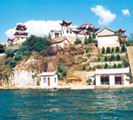 Yunnan, on the Yunnan-Guizhou Plateau in the southwest of China lying just below the Tibetan Plateau and abutting Vietnam, Laos and Burma, is a mysterious land of great natural beauty. It covers an area of 394,000 square kilometers, and has a population of 40,000,000. Even today many Chinese think of it as a ” frontier province ” In few provinces of China is so great a diversity of natural conditions and culture to be found as in Yunnan.
Yunnan, on the Yunnan-Guizhou Plateau in the southwest of China lying just below the Tibetan Plateau and abutting Vietnam, Laos and Burma, is a mysterious land of great natural beauty. It covers an area of 394,000 square kilometers, and has a population of 40,000,000. Even today many Chinese think of it as a ” frontier province ” In few provinces of China is so great a diversity of natural conditions and culture to be found as in Yunnan.
Yunnan has an unique array of fascinating ecotourist resources, including mountains and glaciers snow-capped all year round, lakes and hot springs, alpine landscapes, primeval temperate woodland, and tropical rain forests where elephants and monkeys roam . Forests, totaling nearly 10 million hectares, or eight percent of the nation’s total, cover 24.9 percent of the land of Yunnan, which is China’s haven for plants and animals.
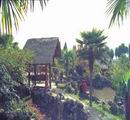 More than half of China’s 30,000 kinds of high-grade plants can be found in Yunnan, which is also home to 3,000-plus kinds of rare animals (55 percent of the national total), 31 kinds of birds (64 percent of the national total), and 130 kinds of reptiles (42 percent of the national total).Meili Snow Mountain with an elevation of 6740 meters, magnificent and precipitous, has not been conquered by men.
More than half of China’s 30,000 kinds of high-grade plants can be found in Yunnan, which is also home to 3,000-plus kinds of rare animals (55 percent of the national total), 31 kinds of birds (64 percent of the national total), and 130 kinds of reptiles (42 percent of the national total).Meili Snow Mountain with an elevation of 6740 meters, magnificent and precipitous, has not been conquered by men.
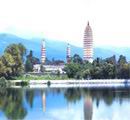 The Lunan Karst topography covers an area of 350 square kilometers and forms ” the first wonder of the world ” the Stone Forest. The Tiger Leaping Gorge , 3,200 meters height from the cliff’s edge to the water surface of the Golden Sand River, where the massive cliffs overhang swirling rapid currents. More than 40 lakes are scattered around the mountains, which from the air look like they are strewn with pearls.
The Lunan Karst topography covers an area of 350 square kilometers and forms ” the first wonder of the world ” the Stone Forest. The Tiger Leaping Gorge , 3,200 meters height from the cliff’s edge to the water surface of the Golden Sand River, where the massive cliffs overhang swirling rapid currents. More than 40 lakes are scattered around the mountains, which from the air look like they are strewn with pearls.
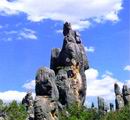 Many rare and endangered species of plants and animals live in Xishuangbanna. The flowers around Kunming, the City of Spring, bloom through all four seasons. Cut off by precipitous mountains from easy communication with the outside world, Shangri-la, referred to in James Milton’s Lost Horizon, may be the last virgin land where one can observe cultures whose layers go back for thousands of years into the past. Picturesque Lijiang, listed as a “World Cultural Heritage City” by UNESCO, is a region of gorges, lakes and active horse breeding.
Many rare and endangered species of plants and animals live in Xishuangbanna. The flowers around Kunming, the City of Spring, bloom through all four seasons. Cut off by precipitous mountains from easy communication with the outside world, Shangri-la, referred to in James Milton’s Lost Horizon, may be the last virgin land where one can observe cultures whose layers go back for thousands of years into the past. Picturesque Lijiang, listed as a “World Cultural Heritage City” by UNESCO, is a region of gorges, lakes and active horse breeding.
The Naxi people who live here still use hieroglyphic writing and wear sheepskin capes.Yunnan is an area of many different national cultures. 26 ethnic minority groups give a rich patina of diversity and color to the Yunnan scene, contributing with their colorful ethnic costumes, their traditional songs and dances, to the attractive life of the cities, the villages, the fairs and the festivals. The Water Splashing Festival of the Dai people, the March Fair of the Bai people, the Torch Festival of the Yi people, keep the traveler so entranced he never wants to leave.
 Yunnan is also one of the cradles of human civilization. The bones of a primitive hominid 1.7 million-years-old have been found in Yuanmou, dinosaur fossils in Lufeng County. From Dali, capital of the ancient Nanzhao Kingdom to the Golden Temple, Black Dragon Pool and many other ancient temples most of which are amazingly intact, Yunnan is a wonderland, with a long history and a deep culture.
Yunnan is also one of the cradles of human civilization. The bones of a primitive hominid 1.7 million-years-old have been found in Yuanmou, dinosaur fossils in Lufeng County. From Dali, capital of the ancient Nanzhao Kingdom to the Golden Temple, Black Dragon Pool and many other ancient temples most of which are amazingly intact, Yunnan is a wonderland, with a long history and a deep culture.
Yunnan is a place of neverending fascination. The stone drums, the Jade Dragon Snow Mountain, the worship not of gods but of the sky, the earth, and the mountains; languages whose origins are lost in the mists of antiquity; and the Burma Road which once provided a gateway of American supplies and aid to war-time China in World War II.
Chengdu
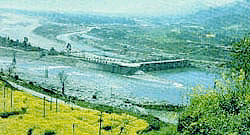 Centrally located in the western Sichuan Plain, Chengdu, the capital of Sichuan Province, is renowned for its fertile land and agricultural wealth which have earned the city the nickname “Storehouse of Heaven”. It covers an area of 3,861 sq. km., of which only 50 sq. km. is in the city proper with a population of 4 million, of whom 1.23 million are urban inhabitants.
Centrally located in the western Sichuan Plain, Chengdu, the capital of Sichuan Province, is renowned for its fertile land and agricultural wealth which have earned the city the nickname “Storehouse of Heaven”. It covers an area of 3,861 sq. km., of which only 50 sq. km. is in the city proper with a population of 4 million, of whom 1.23 million are urban inhabitants.
 Chengdu’s snacks and refreshments have a great reputation. Dumplings made of glutinous rice flour served in soup (Lai Tangyuan), bell-shaped dumplings and pearl-shaped Tangyuan are among Chengdu’s delicacies. Longchaoshou, Tongjing Lane noodles and Husband-and-wife beef slices are some other tasty morsels worth trying. Most Characteristic of them are Lai Tangyuan (stuffed dumplings made of glutinous rice flour served in soup), Longchaoshou, Husband-and-wife beef slices, bell-shaped dumplings, Tongjing lane noodles and pearl-shaped Tangyuan.
Chengdu’s snacks and refreshments have a great reputation. Dumplings made of glutinous rice flour served in soup (Lai Tangyuan), bell-shaped dumplings and pearl-shaped Tangyuan are among Chengdu’s delicacies. Longchaoshou, Tongjing Lane noodles and Husband-and-wife beef slices are some other tasty morsels worth trying. Most Characteristic of them are Lai Tangyuan (stuffed dumplings made of glutinous rice flour served in soup), Longchaoshou, Husband-and-wife beef slices, bell-shaped dumplings, Tongjing lane noodles and pearl-shaped Tangyuan.
Wu Gorge
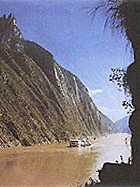 While the magnifcence of Qutang Gorge is left behind, the splendour ot Wu Gorge comes in sight.” Coming out of Qutang Gorge and saling through an open area where the hills are low and the river is gentle,you enter Wu Gorge,which is charactersed by beautiful peaks and steep cliffs on either side Wu Gorges named after Mt Wushan, It extends eastward from the mouth of the Daning Rver in the east of Wushan town.Sichuan province with a length of forty-five kilometers.The gorge is flanked with towerng peaks and steep cliffs.Downstream you have to go through countless twists and turns.
While the magnifcence of Qutang Gorge is left behind, the splendour ot Wu Gorge comes in sight.” Coming out of Qutang Gorge and saling through an open area where the hills are low and the river is gentle,you enter Wu Gorge,which is charactersed by beautiful peaks and steep cliffs on either side Wu Gorges named after Mt Wushan, It extends eastward from the mouth of the Daning Rver in the east of Wushan town.Sichuan province with a length of forty-five kilometers.The gorge is flanked with towerng peaks and steep cliffs.Downstream you have to go through countless twists and turns.
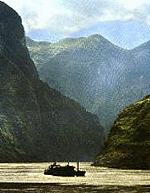 The river now seems to be blocked by the huge moun-tains.now breaks through and changes its direction. The changing course of the roanng river makes it difcult for you to take your bearings.
The river now seems to be blocked by the huge moun-tains.now breaks through and changes its direction. The changing course of the roanng river makes it difcult for you to take your bearings.
The deep gorge is so kaleidoscopc that you may test your eyes on the beautiful scenes every where alalong.The twelve peaks of Mt. Wu-shan make up a most spec-tacular scene The peaks are varied in shape and posture.Some look like green screens.some are shrouded in the cloud and others covered with an-cient pine trees.Among them Shennu(Fairy)peaks most enchanting.The landscapes of the Daning River,Xiangxi River and Shennong Rver provide a unique favour of primitveness with the green mountains and the blue water.
In addition,located in the region of Wu Gorge are such famous walled cities as Wushan,Badong and Zigui.where there are a number of noted historcal sites and where the folkways are so unique and colorful that one can enjoy himself heartly.
Qutang Gorge
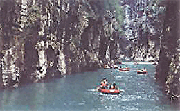 Qutang Gorge extends eastward from White King Town to Daxi Town.Although the gorge is no more than eight kilormeters long and a down stream voyages only a wink.It has a momentum of control-ling the waters from Sichuan on the east and dominating the moun-tains of Hubei on the east.The river is flanked with steep cliffs and towering peaks.Mt.ChiJia on the north and Mt.Baiyan on the south penetrate into the sky facing each other closely with.the crags almost touching in the mid-air dangerous and tottering. Looking from a distance in a fine day.one sees The former resembles a huge pink peach and the later a huge heap of white salt glittering all the time. The two mountains disappear in the mist and cloud every now and then,That is the most Spectacular scene of the Yangtze gorges. The widest spot of the river is about two hundred metres and the most narrow spot is only ten of metres. At Kuimen.the entrance of the gorge.the steep cliffS on either side look like two gigantic door leaves closing in on the roaring river and holding the strategic pass between Sichuan and Hubei perilous in every way.As is depicted in the lines of Du Fu.a poet of the tang Dynasty” all the rivers converge at Fuwan,breaking a way throught the rocks at Qutang .Kuimen has been marvelled at as: the most dangerous pass world.” Darkenging the daylight with only a narrow opening up and the thundering river rolling by vigorousihy, just the thousands of horses galloping ahead.You can’t help marveling at the scene and wondering whether you are salling to the hell.
Qutang Gorge extends eastward from White King Town to Daxi Town.Although the gorge is no more than eight kilormeters long and a down stream voyages only a wink.It has a momentum of control-ling the waters from Sichuan on the east and dominating the moun-tains of Hubei on the east.The river is flanked with steep cliffs and towering peaks.Mt.ChiJia on the north and Mt.Baiyan on the south penetrate into the sky facing each other closely with.the crags almost touching in the mid-air dangerous and tottering. Looking from a distance in a fine day.one sees The former resembles a huge pink peach and the later a huge heap of white salt glittering all the time. The two mountains disappear in the mist and cloud every now and then,That is the most Spectacular scene of the Yangtze gorges. The widest spot of the river is about two hundred metres and the most narrow spot is only ten of metres. At Kuimen.the entrance of the gorge.the steep cliffS on either side look like two gigantic door leaves closing in on the roaring river and holding the strategic pass between Sichuan and Hubei perilous in every way.As is depicted in the lines of Du Fu.a poet of the tang Dynasty” all the rivers converge at Fuwan,breaking a way throught the rocks at Qutang .Kuimen has been marvelled at as: the most dangerous pass world.” Darkenging the daylight with only a narrow opening up and the thundering river rolling by vigorousihy, just the thousands of horses galloping ahead.You can’t help marveling at the scene and wondering whether you are salling to the hell.
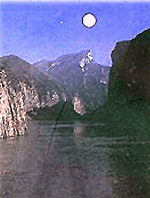 Qutang gorge boasts not only splendid sights but also palces of historical interest concentrated here ,the masterwoks of callgraphy and stone engavings of different dynasties. There are in the region such historical or legendary sites as White King Town. which is the most ancient in the Three Gorges. The former site of the Eight-Element Battle Formation designed by Zhuge Liang Duriing the period of the three kingdoms. Meng Lian ladder, which is legendary, and Feng-xiang crevics and Cuokai goger, which were wrapped in mystery for thousands of years.
Qutang gorge boasts not only splendid sights but also palces of historical interest concentrated here ,the masterwoks of callgraphy and stone engavings of different dynasties. There are in the region such historical or legendary sites as White King Town. which is the most ancient in the Three Gorges. The former site of the Eight-Element Battle Formation designed by Zhuge Liang Duriing the period of the three kingdoms. Meng Lian ladder, which is legendary, and Feng-xiang crevics and Cuokai goger, which were wrapped in mystery for thousands of years.
Nine-Village Gully
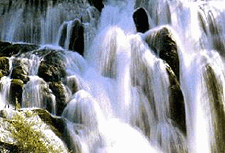 Jiuzhaigou (Nine-Village Gully) is a scenic spot tucked away in the depth of mountains at Nanping, a county in the norihcrn part of Sichuan Provincelt is 470 kilo-metres away from Cheng-du, the provincial capital, with an elevation of about 2.500 metres.The secenic spot actually consists of three major gullies, spread over a total area of 60.000 hectares. which formerly was the site of nine stockaded villages of Tibetans. Hence the name in Jiuzhaigou.
Jiuzhaigou (Nine-Village Gully) is a scenic spot tucked away in the depth of mountains at Nanping, a county in the norihcrn part of Sichuan Provincelt is 470 kilo-metres away from Cheng-du, the provincial capital, with an elevation of about 2.500 metres.The secenic spot actually consists of three major gullies, spread over a total area of 60.000 hectares. which formerly was the site of nine stockaded villages of Tibetans. Hence the name in Jiuzhaigou.
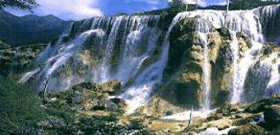 Jiuzhaigou is well-known for its network of alpine lakes, spectacular waterfalls and wonderful vegetation.There are. for instance, 108 terraced lakes in the midst of great mountains where the valleys echo with the roar of cataructs and cliffside springs. The place, therefore. has always enjoyed the reputation of being a “Wonder-land on Earth”. Besides, in the vast primeval rorests there are all kinds of rare birds and animals.
Jiuzhaigou is well-known for its network of alpine lakes, spectacular waterfalls and wonderful vegetation.There are. for instance, 108 terraced lakes in the midst of great mountains where the valleys echo with the roar of cataructs and cliffside springs. The place, therefore. has always enjoyed the reputation of being a “Wonder-land on Earth”. Besides, in the vast primeval rorests there are all kinds of rare birds and animals.  The place is a habitat for the giant panda. A rare animal not to be found else where in the world.
The place is a habitat for the giant panda. A rare animal not to be found else where in the world.
E’mei Mountain
Located in the southwest of Emei County, Sichuan Province, the Emei Mountain is one of thefour Buddliist shrines.The mountain is known for its stiff cliffs, highrising peaks,roating waterfalls, gurgling springs, towering ancient trees and fragrant flowers. It has been described as a beauty spot under heaven” by Chinese men of lettera since ancient times. The highest peak of the is 3,099 metres above sea level. The total rugged road to its summit is 75 kilometres long.In the Eastern Han Dynasty(25-220), monks and priests eame to the mountain to build temples.
 Constrnction lasted l,800 years.The Emei mountain is regarded as the “capital of fairyland and kingdom of monks”. Now there remain only 70 temples on the mountian. There are plcnty of historical sites, and a lot of
Constrnction lasted l,800 years.The Emei mountain is regarded as the “capital of fairyland and kingdom of monks”. Now there remain only 70 temples on the mountian. There are plcnty of historical sites, and a lot of
precious cultural relics on tbe mountain. Inside Baoguo.Temples a Large china statue of Buddha with a height of 2.4 metres made in the Ming Dynasty Looks,alive. bright and shining. A big bell, also made in the Ming Dynasty with a weight of 12.5 tons, has more than 60,000 charac-ters on
it. The sound produced by the bell is deep, and its echo spreads as far as 15 kilometres.
Fuhu Temple, the biggest Buddhist temple on the mounfain, has 13 halls. In the temple, a 6-metre 17-storeyed bronze tower made in the Yuan Dy-nasty(1271-1368) has sone 4,700 engraved Buddhist figurines on it. The 20,000-character Huayan Sutras are well preserved in the temple.
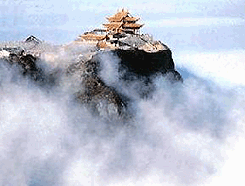 Wannian Temple has a huge bronze statue of Samantab-hadra mounted on a white elephant.made in the Song Dynasty (960-1279). The bronze is 7.35 metres high and weighs 62 tons. Inside the the temple, there are several hundred other bronze or iron statues. The Copper Hall with a gold-plated roof in Woyun Temple, built in the Ming Dynasty on the mountain top, is eight metres high, 4.8 metres wide and 4.3 metres deep. The whole body of the hall was made of copper with a gold plated roof inside the hall, there is a five-metre high bronze statue of Samantabhadra mounted on an elophant and 24 bronze Buddhist images. Outside the hall is a bronze tablet, on which 2,564 characters were engraved by calligraphers Wang Xizhi of the Eastern Jin Dynasty(317-420)and Chu Suiliang of the Tang Dynasty(618-907).
Wannian Temple has a huge bronze statue of Samantab-hadra mounted on a white elephant.made in the Song Dynasty (960-1279). The bronze is 7.35 metres high and weighs 62 tons. Inside the the temple, there are several hundred other bronze or iron statues. The Copper Hall with a gold-plated roof in Woyun Temple, built in the Ming Dynasty on the mountain top, is eight metres high, 4.8 metres wide and 4.3 metres deep. The whole body of the hall was made of copper with a gold plated roof inside the hall, there is a five-metre high bronze statue of Samantabhadra mounted on an elophant and 24 bronze Buddhist images. Outside the hall is a bronze tablet, on which 2,564 characters were engraved by calligraphers Wang Xizhi of the Eastern Jin Dynasty(317-420)and Chu Suiliang of the Tang Dynasty(618-907).
On the top of the moimtain. a cireleof violet,indgo, blue,green, yellow, orange and red lights may be observed in the clouds, and you may feel as if you were caught in the circle, which moves with your shadow. This is the famed “pecious Emei lights” or “Buddha’s halo”. On mountain
slopes, monkeys often come out to”rob” you: they may extend their hands begging for food. If you show your empty hands, they usually let the matter go. But sometimes an in-sistent monkey will try to seize your coat to make sure you really have nothing to offer.
Sichuan
Du Fu Thatched Cottage Park
Du Fu, one of the greatest Tang Dynasty poets, was a famous figure in China’s history. In his life time he wrote hundreds of poems that have lasted for several centuries. Even now his poems are still well recited by people. The Du Fu Thatched Cottage Park was built in 752 when Du Fu went to Chengdu from Gansu The original one no longer exist, but during the seventh century the cottage was rebuilt to commemorate him. In the course of the following years, this area became a large garden covering about twenty hectares, with many towering old trees, green bamboo and quiet, beautiful surroundings. Now people like to visit this place and commemorate the great poet in Chinese history.
Jiuzhaigou
Jiuzhaigou(Nine Stockade Gully), in the northern Sichuan, is close to the Gansu border. It is so named because there are nine Tibetan villages in Jiuzhaigou. Jiuzhaigou covers an area of 600 square kilometers, by now 50 square kilometers of which has been opened to tourists, comprising six scenic spots. In this area you can enjoy the beautiful scenery of lakes, waterfalls, snowy mountains and forests. The place is well preserved as its original natural state.
In December,1992 The Jiuzhaigou Scenic Area was listed in the “Chronology of Recognition of World Heritages” in China.
Emeishan (Mount Emei)
Emeishan (Mount Emei), located in a medieval time warp, receives a steady stream of pilgrims with their straw hats, makeshift baggage, walking canes and fans. It is one of the four sacred Buddhist mountains in China. On the mountain there are many sites of ancient Buddhist activities. Ever since the introduction of Buddhism into China, Buddhist building have been built on the mountain. There are more than one hundred temples and monasteries. Now the main attraction spots include the Baoguo Temple, Fuhu Temple, Leiyin Temple and many other spots. In 1996, Emeishan and the Grand Buddha in Leshan were classified as the world Famous Cultural Relics.
Baoguo Monastery
This monastery was built in the 16th century, enlarged in the 17th century by Emperor Kangxi, and rebuilt in recent years. Its 3.5 meter porcelain Buddha, made in 1415, is housed near the Sutra Library. To the left of the gate is a rockery for potted miniature trees and rare plants.
Wannian Monastery
The temple, built in the 4th century,was1,043 meters above sea level. It was burned several times in the following centuries. The present brick building was reconstructed in the Ming Dynasty. The rest existing buildings were built after liberation. The Brick Hall, a domed building with small stupas on it, was built of brick. In the hall is a statue of the bodhisattva Puxian on a white elephant, 8.5 meters high, cast in copper and bronze. It weighs about 62,000 kilograms.
Golden Summit
At 3077 meters, the magnificent Golden Summit Temple is as far as most hikers make it. Covered with glazed tile and surrounded by white marble balustrades, it now occupies an area of 1,695 square meters. The original temple had a bronze-coated roof, which is how it got the name Jinding “Golden Top” as well as “Golden Summit”.
Mt Huashan
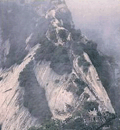 Mt Huashan, also called “The great west Moun-tain” in the past, is one of China’s five sacr-ed mountains. It is located to the south of Huayin County, 120 kilometres east of Xi’an City, Shaan-xi Province, With an ele-vation of 2,200 metres, the mountain overlooks the Huanghe River and the Weishui River the north and links with the Qinling Mountains to the south. Mt Huashan is the tallest among the five great mountains. It is one of the famous mountains as well as a very beautiful scenic spot of China.
Mt Huashan, also called “The great west Moun-tain” in the past, is one of China’s five sacr-ed mountains. It is located to the south of Huayin County, 120 kilometres east of Xi’an City, Shaan-xi Province, With an ele-vation of 2,200 metres, the mountain overlooks the Huanghe River and the Weishui River the north and links with the Qinling Mountains to the south. Mt Huashan is the tallest among the five great mountains. It is one of the famous mountains as well as a very beautiful scenic spot of China.
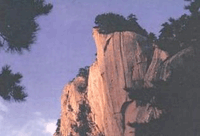 Mt Huashan boasts numerous imposing peaks with sheer pre-cipices and overhanging rocks. It has five peaks, the south one is called the Peak of the Wild Geese, the east one, the Peak of the Rising Sun, the west one, the peak of Lotus, the Central one, the Peak of the Charming Maiden and the north one, the Peak of the Cloud Terrace, Teh latter two are not so tall as the former three, yet each presents a kind of scenic beauty of its own. The three main peaks, acclaimed as “the three magnificent peaks under heaven”, stand like the three legs of a tripod in the blue sky.
Mt Huashan boasts numerous imposing peaks with sheer pre-cipices and overhanging rocks. It has five peaks, the south one is called the Peak of the Wild Geese, the east one, the Peak of the Rising Sun, the west one, the peak of Lotus, the Central one, the Peak of the Charming Maiden and the north one, the Peak of the Cloud Terrace, Teh latter two are not so tall as the former three, yet each presents a kind of scenic beauty of its own. The three main peaks, acclaimed as “the three magnificent peaks under heaven”, stand like the three legs of a tripod in the blue sky.
Places of historical interest and scenic spots, temples and pavilions can be found every where. Owing to its peculiar lie the mountain has its own style of architecture. Many towers, caves and stone steps are built according to local conditions. The cloud-enshrouded cliff path, the sculptured rocky cliff, the floating-in the air Somersault Cliff, the cliff-excavated Thoursand-Foot Precipice, the Hundred-Foot Valley, Laojun’s Furrow, Ear Touching Cliff, Up the Heaven’s Ladder, the Heaven Dragon Peak and so on are all mar-vellous views of precipitous and perilous cliff paths.
Dayan pagoda and Xiaoyan pagoda
Dayan(big wild goose) pagoda and Xiaoyan pagoda
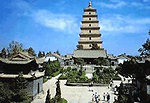 Dayan and Xiaoyan Pagodas in Xi’an are still well preserved from Tang Dynasty. They are not only famous at home, but have high reputation in the world as well.
Dayan and Xiaoyan Pagodas in Xi’an are still well preserved from Tang Dynasty. They are not only famous at home, but have high reputation in the world as well.
Dayan pagoda was first con-structed in 3rd year of regime period of Gaozong of Tang Dynasty. Mounting on Ci’en Hill, it is also called Ci’en pagoda. Ci’en temple was built by Prince Lizhi in memory of his mother Princess Wende in 22nd of Zhenguan Region of Tang Dynasty. Primirily only five floors were erected and reconstructed in regime of Wuzetan period. Then by recovery and reconstruction several times, the pagoda possesses seven floors with total 64 m high as square and taper in size.
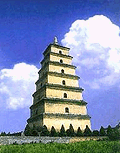 Along two sides of south gate on first floor of Dayan pagoda, two steles were bossed with handwritting by famous cal-ligrapher in Tang Dynasty Zhe Suiliang. Flowers carved at edges of the steles with vivid pattern is for decoration, which is all important to study calligraphs, draw-ings and carving in Tang Dynasty.
Along two sides of south gate on first floor of Dayan pagoda, two steles were bossed with handwritting by famous cal-ligrapher in Tang Dynasty Zhe Suiliang. Flowers carved at edges of the steles with vivid pattern is for decoration, which is all important to study calligraphs, draw-ings and carving in Tang Dynasty.
Xiaoyan pagoda was famous Buhhist temple in Tang Dynasty. With 15 steps brick building, it is precious architecture relics. Most interesting is that the pagoda had cracked three times and closed naturally which also attracts attentions and were recorded in one stele above lintel of the gate. After that it stood up earthquakes six times and even recovered the cracks naturally, which is deedly strange.
Shanxi
 Shanxi is not only one place of Chinese origin, but also a source of those age-old culture. The purpose of the Shaanxi Window is providing a window which can promote your under-standing to Shaanxi. Welcome to the Shaanxi Window! Here, the people who have the same clan can visit wellknown scenic spots, discuses things of an-cient times and present age, look at changes of the ways of the world, realize the fond dream of a descendant of the Yellow Emperor; A tourer can also understand the abundance and depth of the ancients’thought and greatness of con-temporaries.
Shanxi is not only one place of Chinese origin, but also a source of those age-old culture. The purpose of the Shaanxi Window is providing a window which can promote your under-standing to Shaanxi. Welcome to the Shaanxi Window! Here, the people who have the same clan can visit wellknown scenic spots, discuses things of an-cient times and present age, look at changes of the ways of the world, realize the fond dream of a descendant of the Yellow Emperor; A tourer can also understand the abundance and depth of the ancients’thought and greatness of con-temporaries.
 Xi’an known as Chang’an in ancient times, is famed all over the world for it’s glorious history. Specialists and scholars regard it as an inexhaustible treasurehouse of literature while heads of state from many countries and people from all walks of life turn their eyes to this tourist attraction, trying to broaden their knowledge of chinese civilization.
Xi’an known as Chang’an in ancient times, is famed all over the world for it’s glorious history. Specialists and scholars regard it as an inexhaustible treasurehouse of literature while heads of state from many countries and people from all walks of life turn their eyes to this tourist attraction, trying to broaden their knowledge of chinese civilization.
Shanxi History Museum
Shaanxi Province stands out as one of the cradles of the Chinese nation and its long civilization. Before the 10th century, it had been the political, economic and cultural center of China. For a duration of more than 1,100 years, Xi’an served as the capital for fourteen feudal dynasties, including the Zhou, the Qin, the Han,the Sui and the Tang. Shaanxi Province has abundant cultural and historical relics. There are 35,750 identified historical sites across the region, with 55 at the state level and 372 at the provincial level. It houses 56,000 pieces of historical relics,with 3,526 at the first-class level and 123 at the state level. The province ranks first on the national list in the density, quantity and grade of cultural relics. Shaanxi Province is reputed as a
natural Chinese history museum, which houses a complete array of historical sites representative of different historical periods. Among the famous historical relics are the site of the Lantian Ape Man over one million years of age; the site of a 6,000- year-old primitive village at Banpo; the Mausoleum of the Yellow Emperor(worshipped as their first ancestor by the Chinese people); the site of the capital city of the Zhou Dynasty;the First Qin Emperor’s Mausoleum; Emperor Wudi’s Mausoleum and its
stone carvings; Sakyamuni’s finger bones and other treasures in the Underground Palace of the Famen Temple; Shaanxi History Museum with modern architectural features; Xi’an Forest of Steles(known as a “library of stone inscriptions” of high artistic value); Qiling Mausoleum for
Empress Wu Zetian and Emperor Gao Zong(Li Zhi); Xi’an City Wall (the most sizable and complete of its kind in China); the sacred revolutionary base Yan’an and its relics.
The Terra-cotta
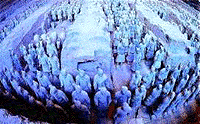 Another indication of the probable magnitude and grandeur of the not-yet-excavated mauso-leum is the vaults contain-ing an army of guards for the first emperor which have been discovered 1,500 metresto the east of the tomb. Commune members digging an irrigation well made the first discovery by chance in 1974 of what is now called Vault No. l. huge underground chamber containing.Six thousand terracotta sokliereand their horses and chariots, as grand as Qin Shi Huang’s actual conquering army. This is the most important revelation in recent Chinesearehaeology,both for its vast scale and for the realistic detail and aesthetic achievement of The buried seulpiures. Though Vault No.1 is called avault or pit, it actually con-sists of a series of eleven parallel subterranean cor-ridors (each about three metres wide,
Another indication of the probable magnitude and grandeur of the not-yet-excavated mauso-leum is the vaults contain-ing an army of guards for the first emperor which have been discovered 1,500 metresto the east of the tomb. Commune members digging an irrigation well made the first discovery by chance in 1974 of what is now called Vault No. l. huge underground chamber containing.Six thousand terracotta sokliereand their horses and chariots, as grand as Qin Shi Huang’s actual conquering army. This is the most important revelation in recent Chinesearehaeology,both for its vast scale and for the realistic detail and aesthetic achievement of The buried seulpiures. Though Vault No.1 is called avault or pit, it actually con-sists of a series of eleven parallel subterranean cor-ridors (each about three metres wide, 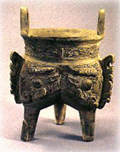 three metres high,and over two hundred metres long) in which the columns of warriors were arrayed. The entire vault is 63 metres wide, and occupies an area of l4,260 square metres (3.5 acres). The floor is paved in brick, 5 metres below soil level. Wooden pillars and roofing planks provided support for the earthen walls and covering, though the vault col-laped and was filled in when it was raided by looters at the time of the fall of the Qin Dynasty 206 B.C.The weapons and armor of the infantrymen vary according to their placament in the carefully designed military formation.
three metres high,and over two hundred metres long) in which the columns of warriors were arrayed. The entire vault is 63 metres wide, and occupies an area of l4,260 square metres (3.5 acres). The floor is paved in brick, 5 metres below soil level. Wooden pillars and roofing planks provided support for the earthen walls and covering, though the vault col-laped and was filled in when it was raided by looters at the time of the fall of the Qin Dynasty 206 B.C.The weapons and armor of the infantrymen vary according to their placament in the carefully designed military formation.
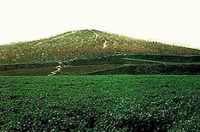 In May 1976 a second underground complex of warriors, called Vanlt No.2, was discovered twenty metres to the north of Vault No.l This led to the uncovcring of Vault No.3, quite close to the first two pits. The ottrer vaults are all smaller than Vault No.l Vault No.2 contains approximately l,4O0 cavalrymen and horses with a more complex layout than No.l. Bronze Chariots from the Qin Cemetery.
In May 1976 a second underground complex of warriors, called Vanlt No.2, was discovered twenty metres to the north of Vault No.l This led to the uncovcring of Vault No.3, quite close to the first two pits. The ottrer vaults are all smaller than Vault No.l Vault No.2 contains approximately l,4O0 cavalrymen and horses with a more complex layout than No.l. Bronze Chariots from the Qin Cemetery. 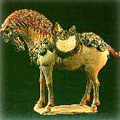 Two bronze chariots were unearthed from the western side of the Qin Cemetery in 1980. Each chariot has four bronze horses and a bronze figure driver. Its size is about half of a modern combination of a man, a carriage and four horses. Its carriage cab and bronze horses are richly ornamented with very exquisite craftsmanship.
Two bronze chariots were unearthed from the western side of the Qin Cemetery in 1980. Each chariot has four bronze horses and a bronze figure driver. Its size is about half of a modern combination of a man, a carriage and four horses. Its carriage cab and bronze horses are richly ornamented with very exquisite craftsmanship.
More about the Mogao Grottoes
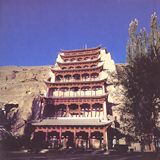 Dunhuang lies at the western end of the Hexi Corridor in Gansu Province in Northwest China, an oasis on the eastern edge of Takli- makan Desert. It is nourished by melted snow water from the Qilian Mountains. The ancient town used to be an important stop-over point on the Silk Road. The name “Dunhuang” was given in the Han Dynasty. In Chinese “Dun” means grandness and ” Huang” means prosperity. In the 2nd century B.C. Emperor Wudi of the Han Dynasty sent imperial envoy Zhang Qian to the Western Regions, opening up a trade route which was to be known as the “Silk Road” in history.The imperial court set up Dunhuang Prefecture in A.D. 111 and Dunhuang became a strategic town. Through this route Chinese culture and products, especially silk, were introduced to European and Middle East coun tries, and foreign culture and products such as Buddhism of India came to central China. Much of Buddhism is propagated through artistic forms, which were soon assimilated into the Chinese traditional culture. The result was that many Buddhist images were carved in caves in mountain cliffs along the Silk Road. Many of them have been well preserved. The best are those at Mogao in Dunhuang.
Dunhuang lies at the western end of the Hexi Corridor in Gansu Province in Northwest China, an oasis on the eastern edge of Takli- makan Desert. It is nourished by melted snow water from the Qilian Mountains. The ancient town used to be an important stop-over point on the Silk Road. The name “Dunhuang” was given in the Han Dynasty. In Chinese “Dun” means grandness and ” Huang” means prosperity. In the 2nd century B.C. Emperor Wudi of the Han Dynasty sent imperial envoy Zhang Qian to the Western Regions, opening up a trade route which was to be known as the “Silk Road” in history.The imperial court set up Dunhuang Prefecture in A.D. 111 and Dunhuang became a strategic town. Through this route Chinese culture and products, especially silk, were introduced to European and Middle East coun tries, and foreign culture and products such as Buddhism of India came to central China. Much of Buddhism is propagated through artistic forms, which were soon assimilated into the Chinese traditional culture. The result was that many Buddhist images were carved in caves in mountain cliffs along the Silk Road. Many of them have been well preserved. The best are those at Mogao in Dunhuang.
The Dunhuang Grotto Art is composed of the Cave and Yulin Grottos in Anxi. Carving of the Mogao Grottoes , commonly known as 1,000- Buddha Caves, began in AD 366 and continued through a dozen dynasties including the Northern Liang , Northern Wei, Western Wei, Northern Zhou, Sui, Tang, Five-Dynasties Period, Song, Huihe, Western Xia and Yuan. The extant 492 caves preserve more than 2, 000 color statues and 45,000 square meters of murals. The mural themes depict Buddha portraits, stories and interpretations of Buddhist scriptures, Buddhist history, legends, portraits of devotees and various decorative patterns. They describe different ethnic groups, people’s lives such as nobles’ outings, singing, dancing and music, farming, fishing and hunting, acrobatics and martial art practice, foreign envoys and merchants on the Silk Road. Some scholars liken these murals to a “library on the wall, ” In the early 20th century some 50,000 pieces of cultural relics were found in the Scripture-Keeping Cave including handwritten documents and more than 1,000 pieces of silk painting, graphic painting , embroidery and calligraphy. Put together the art works would form a 25-kilometer-long art gallery. The Mogao Grottoes were dug in loose sedimentary conglomerate of the the Quaternary Period. Some parts collapsed in earthquakes. But the dry weather has preserved the basic outlook of the cliffs. In the 1940s the Dunhuang Art Research Institute was established at Mogao. After the founding of the People’s Republic of China, the new government began an overall repair and reinforcement project on 39 caves, saving 1,800 square meters of murals and 200 color statues. The Western 1,000-Buddha Cave and Yulin Grottos at Anxi have been public after renovation.
Grottoes in Dunhuang are a national treasure of China and a cultural heritage of the world. In 1962 the State Council put them among China’s first key cultural relics under state protection and in 1991 the UNESCO put them on its list of world natural and cultural heritages.
Mogao Grottoes
Located in Gansu Province near Dunhuang
Building started in 366 AD and continued for 10 centuries.
The practice of carving rock temples dedicated to the Buddha originated in India. The practice came to China from the west, one of the earliest examples being at Dunhuang, Gansu Province (Mogao Grottoes).
According to legend, in 366 AD the vision of a thousand monks inspired a wandering monk, Yue Zun, to cut the first of hundreds of caves into the sandstone cliff face of Mingsha mountain. The legend describes how, arriving at the oasis below the cliffs, he saw myriad golden lights on Mount Sanwei, as though thousands of Buddhas were giving off beams of lights. He subsequently dug the first cave and also cut a statue of the Buddha. Thus started the beginning of a Buddhist way-station on the Silk Road. Today, 492 grottoes are still standing in the 1600-metre-long cliff face. Together they contain over 2,000 terra-cotta statutes (the natural rock is to soft to be carved) and over 45,000 separate murals.
Northern/Western Wei / Zhou Dynasty Period (386 – 557 AD)
From this beginning in the Six Dynasties (or Northern and Southern partition) Period, and for the years of the Northern and Western Wei Periods, twenty-three caves were created showing Indian influences, reflecting the characteristics of the country of origin of Buddhism. The facial features of the sculptures of this period show broad faces and prominent cheeks, fine eyebrows, thin lips, high-set nose, and the body is generally slender and draped in a light clinging robe.
The paintings which adorn the cave walls illustrate parables and stories (Jataka tales) depicting the life of the Buddha. The ceilings are decorated with geometric patterns, animals and legendary figures from Chinese mythology.
The Zhou Dynasty Period caves have the same general characteristics as the Wei.
The caves were constructed during this period by the Turkic-speaking Tobas who formed the Wei Dynasties. They deliberately adopted Chinese manners and customs. At the break-up of the Wei (due to friction concerning the traditional Tobas lifestyle), the Northern Zhou (the ones who unsuccessfully tried to revert to traditional Tobas traditions) remained in power, until the throne of the Northern Zhou was usurped by a general of Chinese or mixed Chinese-Tobas ancestry, Yang Chien.
Sui Dynasty (589 – 618 AD)
The ninety-five caves from this time date from just thirty-eight years. The unique Indian influence is gone, and the statues are often shown in the sitting position, the faces express greater warmth and humanity, less majesty and the clothing is more softly draped. The faces are fuller, with the ear lobes longer and the body halves are not always proportional. Ananda and Kashyapa, disciples of the Buddha are sculpted for the first time.
The paintings from this period are also remarkable for the richness of composition and design. The theme remains the life of the Buddha, but the garments are now ornately decorated, with the men wearing Chinese clothes and the women wearing slim robes with narrow sleeves. Sui artists have in some caves painted over the work of the Wei artists.
The founder of the Sui, General Yang Chien, prudently put all the sons of the Wei emperor to death, and set out on a series of wars that would unite both the North and South for the first time in 360 years. The Sui was short-lived and transitional. The second Sui emperor, the general’s son, Yang Ti, was assassinated by a noble family of Turkish-Chinese descent, who then formed the Tang Dynasty at Chang’ An (Xian). Sadly, the Tobas are erased from history.
Tang Dynasty (618 – 907 AD)
The peak artistic achievements were made during the Tang Dynasty, where two hundred thirteen caves were hewn from the sandstone cliffs. The figures are characterized by being more realistic (although on a much larger scale). The small wall niches, which in earlier years were places for statues, became small rooms, some having multiple levels. As far as size, two large Buddhas were carved during this period, one being 100 feet and another rising 75 feet high.
The paintings during this period also tell the stories of the Buddha, and include pictures of Bodhisattvas, as well as the images of Tang Dynasty nobles and aristocrats. The influence of Persia and India are seen in the often-recurring mandalas, and by the end of the Tang period, multi-limbed and eyed statues started to appear.
The Tang Dynasty, formed by Li Shi-min (T’ai Tsung), was the second centralized Chinese Dynasty.
Later Dynasties
During the Five Dynasties (907-960 AD) and Song Dynasty (960 – 1280 AD) Periods, the inhabitants began to enlarge some of the caves and completely transform others. Thirty-three were made during the Five Dynasties, ninety-eight from the Song Dynasty and three from the Western Xia (or Xi Xia) (1038-1280 AD). The most outstanding is a wall mural that depicts the main features of the terrain from Taiyuan in Shanxi Province to Zhenzhou in Hebei Province, including the representation of over 100 structures standing at the time in the Wutai Mountains.
Characterizations of the artwork during this period are that it is repetitive, and lacks the vitality of earlier eras. It is during this time that the Mogao Grottoes became an artistic backwater.
During the Mongolian Yuan Dynasty (1280-1368 AD) nine new caves were cut into the north face of the cliff, there being no room in the southern face for expansion. These caves are small and are of Mongolian influence. Also large frescoes were painted, many of the figures representative of the Tibetan pantheon.
The Ming Dynasty (1368 – 1644 AD) made no contributions to the cave complex, and the Qing Dynasty (1644 – 1911 AD) additions lack distinction, most of the artists work from this period being redecoration.
In 1907, the British explorer Sir Aurel Stein heard the rumors of the fabulous horde of treasure found by the Taoist monk, Wang Yuan. These treasures had been sealed in a cave to protect it from invaders. It contained texts in Chinese, Tibetan, and other Central Asian languages. The sacking of the Dunhuang (Mogao) Grottoes began in earnest, with the British Museum receiving 29 packing crates of manuscripts, scrolls, paintings, and art relics. The following year, the French explorer Pelliot came and made off with 6,000 scrolls and a collection of paintings.
The Feat of the Yellow River
The Yellow River runs ceaselessly day and night. it has nurtured the Chinese nation and bred the Chinese civilization. The Yellow River is what we proud of the most. The Yellow River from its place of origin passes Qinghai and Gansu, turns north at ningxia’s shizuishan to Inner Mongolia. Then the Yellow River becomes mild and quite. The Yellow River’s flow has brought the grasslands with lushness and richness. Inner Mongolia is a beautiful and charming place, decorated by colorful mountains, river, forests, grasslands, deserts and lakes. In pleasantly cool summer and autumn days, the vast grasslands beyond the Great Wall are more graceful and enchanting. Inner mongolia has always enjoyed the reputation of being the home of singing and dancing. Horseracing, wrestling and archery are regarded as”the three skill of men”among the Mongolia people and well- known in China and abroad. The traditional Nadamu Fair has a rich flavour of power and competition. The valiant, industrious and intelligent Mongolia people have created the bright grassland civilization and left numerous ancient relics and historic sites. The most attracting one is the Mausoleum of Genghis Khan in the Ortos Grassland, a must place that all tourists visit. Left the grasslands, the Yellow River heads its way south and comes to the Loess Plateau. The fierce water of the Yellow River as a sharp sword cuts the plateau into two pieces. The deep gorge it made becomes the natural demarcation between Shanxi Province and Shanxi Province. This is the Jin-Shan Gorge as it is usually called.
At the valley between Ji County of Shanxi and Yichuan County of Shanxi, the Yellow River creates the Hukou Waterfall, the second largest waterfall in China. The pouring water of the Yellow River from the height of 70 meters falls to the stone valley which is only 40 meters in width, splashing high spray with thundering noises.
On the Shanxi side of the Jin-Shan Gorge, the landscape is splendid and beautiful. The long history has left Shanxi abundant cultural heritages and wonderful tourist sites. The legendary monarchs of Yao, Shun and Yu all founded
their capitals in Shanxi. The well-known Nanshan Temple and Buddhist Light Temple in the Tang Dynasty, The Wood Pagoda of the Liao Dynasty in Ying County, the murals in the Yongle palace of the Yuan Dynasty, the Yungang Grottoes in Datong, the Old Stone Age relics in Dingcun and Xujiayao, relics of the Yangshao culture, the ancient city in Pingyao, the Nine Dragon Wall in Datong, as well as ancient murals, painted sculptures, carved stones and glazed products scattered all over the province are all valuable historic and cultural treasures. Shanxi is also well-known as “the cradle of China`s traditional operas”. Many traditional operas, with different types, simple and unconstrained styles, simple and unconstrained styles, have been handed down from the ancient times. The rich tourist resources in Shanxi have been attracting more and more domestic and foreign tourist coming for sight-seeing, root- seeking and novelty-hunting.
In the Jin-Shaan Gorge, the Yellow River is blocked by the Qing Mountains and turns to the western Henan. Its rapids cut off the solid rocks at Shhan country and made the precipitous Sanmenxia Gorge. At Mengjin County the Yellow River enters the grand plains created by itself and then winds its way eastward.
The huge amount of silt the Yellow River brought from the Loess Plateau was deposited in the plains and made the riverbed higher and higher and becomes the world-famous “suspension river.
The ancient Chinese people lived for generations in this old land made by the Yellow River and created the brilliant Chinese ancient culture, left us abundant cultural heritages. The ancient walls, tombs , architectures, carved stones are scattered over the Central Plains reflect the glory of the ancient Chinese civilization.
The central Plains is a museum of the history of the Chinese people. You can see the relics of primitive man in Yunyang of Nanzhao and in Xiaonanhai of Anyang, as well as the cultural relics in the Yangshao Village of Mianchi County and in the Dahe Village of Zhengzhou City.
The Central Plains, the center of the land, was a place contested by all military force of every dynasty. It was also ideal for different dynasties to found their capitals in the plains. Luoyang was the capitals for nine dynasties. The White Horse Temple in Luoyang, built in the Han Dynasty, may be rated as the first Buddhist temple in the Central Plains. The Longmen Grottoes, shaped from the Northern Wei Dynasty to the Tang Dynasty, has the reputation as one of the three Buddhist art treasure-houses in China. Kaifeng was the capital for seven dynasties. The famous relics such as the Iron Pagoda, the Dragon Pavilion the Xiangguo Temple are acclaimed by visitors as the acme of perfection. The Street of the Song Capital gives tourists a place to experience the custom of the Song Dynasty. Anyang was the capital for five dynasties. The numerous colorful relics in the Museum of the Yin Dynasty Ruins display the custom, politics and culture in the Yin Dynasty. The Gully of Ten Thousand Buddhas, or the Wanfogou , is the largest forest of pagodas with reliefs.
Zhengzhou, the earliest capital of the Shang Dynasty was found so far, is the birthplace of trade activities in China. With the long history of trade, Zhengzhou has become the famous business city in the Central Plains.
The numerous famous cultural cities and historic sites in the Central Plains form a colorful humane scenery and attract visitors from China and other countries.
Left the Central Plains, The Yellow River arrives at Shandong, a beautiful land with intelligent people.
In the Spring and Autumn Period and the Warring States Period, the east part of Shandong was the Qi State and the west part the Lu State. This is why Shandong is called “the land of Qi and Lu”.
Qufu is the hometown of Confucian and the neighboring Zhou County is the hometown of Mencius. The two are the best place to understand the traditional Chinese culture.
Not far away from the hometowns of Confucious and Mencius is the Tai Mountain, which is regarded as the most respected mountains in the China because the Tai Mountain is located in the east where the sun rises.
Jinan, the capital of Shandong Province, is an ancient city and called “the City of Springs” as there are many springs in the city.
Many places in Shandong are worth visiting, such as the capital city of the Qi State, the hometown of Pusongling in Zibo, Weifang-the capital of kites, Qingdao, Yantai-a world-famous city for grape wine, Weihai City and the Yimeng Mountain Area. The Yellow River traveled for5, 464 kilometres, and its indomitable spirit has always been impelling the Chinese People to keep forging ahead. The mighty torrent of the Yellow River joins in the blue sea at the point between Kenli County and Lijin County of Shandong. The Yellow River takes the Chinese civilization to the world.
Brief Introduction of Xi’an
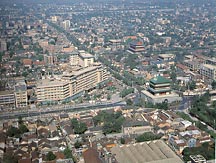 Xi’an was one of the most important cradles of Chinese civilization. It marked the start of the famous “Silk Road” that linked China with central Asia and the Roman Empire. And it served as the first capital of a unified China and capital of 11 dynasties periodically from the 11th century B.C. to the early 10th century A.D. Xi’an, or Chang’an as it was called in ancient times, is known as the city of “Everlasting Peace.” Located between rivers and mountains in the center of the fertile Guanzhong Plain in Shaanxi Province, Xi’an–the provincial capital–was a natural place to nurture the nation’s civilization.
Xi’an was one of the most important cradles of Chinese civilization. It marked the start of the famous “Silk Road” that linked China with central Asia and the Roman Empire. And it served as the first capital of a unified China and capital of 11 dynasties periodically from the 11th century B.C. to the early 10th century A.D. Xi’an, or Chang’an as it was called in ancient times, is known as the city of “Everlasting Peace.” Located between rivers and mountains in the center of the fertile Guanzhong Plain in Shaanxi Province, Xi’an–the provincial capital–was a natural place to nurture the nation’s civilization.
In the Neolithic Age, about 6,000 years ago, excavations show a matriarchal clan was formed at Banpo village in the region. Thousands of years later, the Zhou Dynasty kings established their capital in settlements only a few miles from the present-day city. In 231 B.C., Qin Shi Huang, the first emperor of unified China, set about enlarging the settlement of Xiangyang, about 15 miles northwest of the city. This town, established under earlier Qin rulers as the capital, became heavily populated, so that in 213 B.C., Qin Shi Huang decided to move his court to the south bank of the Wei River. A vast palace was begun, however, work was never completed in his lifetime. Some years later when the Qin fell to the Han (206 B.C.), this and most of the other palaces were destroyed. The conqueror, Liu Bang, first emperor of the Han Dynasty, also established the site of his capital only a few miles north of modern Xi’an.
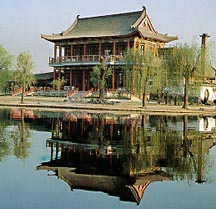 From about 35 A.D., the town went into a decline that lasted about five and a half centuries, until, in 583 A.D., the Sui emperor, Wen Di, established his capital southeast of Chang’an. The city flourished and developed so quickly under the Tang Dynasty that in time it became the most important city in Asia, with a population of more than a million people living in a vast, well-planned area protected by large walls with ramparts. The area occupied by the old city was greater than that of present-day Xi’an. For over a millennium, from the Second Century B.C., China’s silk was transported from Xi’an to central Asia and Europe. Although damaged by several wars, Xi’an, covering 880 square miles and with a population of 3,915,000 (6,000,000 in the urban area) still contains a host of historical sites.
From about 35 A.D., the town went into a decline that lasted about five and a half centuries, until, in 583 A.D., the Sui emperor, Wen Di, established his capital southeast of Chang’an. The city flourished and developed so quickly under the Tang Dynasty that in time it became the most important city in Asia, with a population of more than a million people living in a vast, well-planned area protected by large walls with ramparts. The area occupied by the old city was greater than that of present-day Xi’an. For over a millennium, from the Second Century B.C., China’s silk was transported from Xi’an to central Asia and Europe. Although damaged by several wars, Xi’an, covering 880 square miles and with a population of 3,915,000 (6,000,000 in the urban area) still contains a host of historical sites.
FOREST OF STELE:
The Forest of Stele, which is located on the site of the ancestral temple of the Tang Dynasty. The Forest of Stele was first founded in 1090 A.D. during the Song Dynasty. It is the oldest and richest collection of steles in China. The stele are numerous enough to be likened to a forest, hence the name. This museum consists of six large exhibition halls, seven corridors and a stele pavilion. There are more than 1,000 stele of eight dynasties from the Han down to the Qing. They are of great value to historians and for the study of calligraphic development.
MAUSOLEUM OF QIN SHI HUANG AND MUSEUM OF THE QIN TERRACOTTA FIGURES:
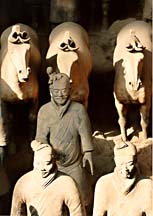 Qin Shi Huang was the founding emperor of the Qin Dynasty. His tomb is on the south bank of the Wei River, about three miles east of the country town of Lintong. It is one of China’s most important historical sites, and has been named a World Heritage Site by UNESCO. Begun in 247 B.C., when Qin Shi Huang was enthroned at the age of 13, the mausoleum is in fact a deep and magnificent underground palace. According to records, more than 700,000 people were employed to construct it, and the work took 36 years to complete. In 1974 and 1976, three massive army vaults were discovered. In Vault No. 1, the largest, 6,000 life-size terra-cotta figures of armed warriors and horses were buried. An underground feat of civil engineering, Vault No. 1 is 351 yards long from east to west, 68 yards wide from north to south, and 5.47 yards deep, covering an area of 15,601 sq. yd. The three army vaults were ascertained by archaeologists to be pits for burial objects accompanying the tomb of Qin Shi Huang. In October 1979, an on-site museum was built above Vault No.1. Since then, two additional structures have been built to cover vaults two and three Ranging from 5.8 to 6 ft. in height, the vivid life-size warrior figures are clad in armor or short gowns belted at the waist, with leggings and tightly-lashed boots, and holding real weapons—bows and arrows, swords and spears.
Qin Shi Huang was the founding emperor of the Qin Dynasty. His tomb is on the south bank of the Wei River, about three miles east of the country town of Lintong. It is one of China’s most important historical sites, and has been named a World Heritage Site by UNESCO. Begun in 247 B.C., when Qin Shi Huang was enthroned at the age of 13, the mausoleum is in fact a deep and magnificent underground palace. According to records, more than 700,000 people were employed to construct it, and the work took 36 years to complete. In 1974 and 1976, three massive army vaults were discovered. In Vault No. 1, the largest, 6,000 life-size terra-cotta figures of armed warriors and horses were buried. An underground feat of civil engineering, Vault No. 1 is 351 yards long from east to west, 68 yards wide from north to south, and 5.47 yards deep, covering an area of 15,601 sq. yd. The three army vaults were ascertained by archaeologists to be pits for burial objects accompanying the tomb of Qin Shi Huang. In October 1979, an on-site museum was built above Vault No.1. Since then, two additional structures have been built to cover vaults two and three Ranging from 5.8 to 6 ft. in height, the vivid life-size warrior figures are clad in armor or short gowns belted at the waist, with leggings and tightly-lashed boots, and holding real weapons—bows and arrows, swords and spears.
BIG GOOSE PAGODA:
Located a couple of miles south of Xi’an, the Big Goose Pagoda, the city’s emblem, was first built in 653 A.D. as part of the Ci’em. Xuan Zang, a renowned monk returned from a pilgrimage to India and neighboring countries, proposed that the pagoda be built to store Buddhist scriptures he had brought back. Xuan Zang was made abbot of the temple, where be translated the scriptures into Chinese. From 701 to 704, the five-story pagoda was rebuilt into a seven-story, 331 ft. high structure with stairs winding to the top floor. Built with gray bricks, this pavilion-like pagoda with arched portals on each floor is a masterpiece of Buddhist architecture with a distinct Chinese style.
SMALL GOOSE PAGODA:
This temple is near the Big Goose Pagoda, and was built in 707 AD It has 15 stories and is 148 ft. high. It has a fine and delicate style. On the north and south doors are exquisitely-carved ivory designs and Buddhist figures.
BANPO MUSEUM:
This Neolithic site is a few miles from Xi’an. The Banpo people settled here some 6,000 years ago. They cultivated their land, built horses, and lived as primitive clan. Five excavations since 1954 have uncovered a village of 45 houses, stone-age pottery, tools, and bones. The site covers an area of 60,000-square yards. It is divided into living quarters, a pottery-making center and a graveyard. The museum built to protect the site covers some 33,400 square feet.
The Silk Road
As one of the journalists drumming the fanfare for Adelaide’s Crafers Highway earlier this year – a construction widely regarded as an infrastrucutral, social and economic miletone – it comes as a humbling experience to be standing only a few months later at the crossroads of history.
But just what feature of the ancient trading route that is China’s Silk Road could be confidently described as the definitive crossroads? Xi’an, Dunhuang, Turpan, Urumqi, Lanzhou? Kashgar, perhaps, at nearly the westernmost point of China? A story about the Silk Road would be such an easier one to tell if there were a zenith, a place you visited from which you could walk away saying … “well, there you go, that’s the high point of the Silk Road.”
Take Jiayuguan Pass – the “Impregnable Pass under Heaven” – for instance. Now there’s a contender for the top spot, surely? The name has such a commanding authority. The Jiayu fort at Jiayuguan Pass, which stands at the western end of the Great Wall of China, lies between the Qilian and Mazong Mountains.
 Taking a camel to breakfast
Taking a camel to breakfast
… returning from the “singing sands” at Dunhuang
Traders prepare for the day ahead, Kashgar Bazaar.
 It once guarded the east-west passageway in and out of China along the Silk Road route (there are three recognised Silk Road routes, north, south and central and group tours can touch on features of all three, depending on who designed the itinerary).
It once guarded the east-west passageway in and out of China along the Silk Road route (there are three recognised Silk Road routes, north, south and central and group tours can touch on features of all three, depending on who designed the itinerary).
It takes some effort to get there, too, with an air connection from Beijing to where the Silk Road crosses the Yellow River at Lanzhou, an overnight train to Jiuquan and a coach ride of an hour or so from there. You might wonder what the armies of ancient dynasties must have thought of their careers to have been stationed there. A legend involving the throwing of a pebble against a stone in order to test your likelihood of returning suggests soldiers were glad to leave this isolated outpost.
Consisting of three inner and outer walls and several lines of defense, the now refurbished fort is an impressive testimony to the voracity with which dynastic China guarded itself. But the high point of a Silk Road tour? Naah.
Surely then, the famous Mogao Grottos near Dunhaung in Gansu Province, reputed to be the greatest store of Buddhist art in the world, would be near the top of the list. It was from Mogao where Buddhism spread south and east through China, helping to shape the religious sphere of the nation.The first cave of the Mogao Grottos was carved out of the cliff-face in 366AD. There are 492 caves spread along 1600 metres of cliffs with 2,415 statues within and 45,000 square metres of extraordinary murals adorning the cave walls and ceilings. The piece de resistance is a Buddha statue standing more than 35 metres high. Even if you have only a passing interest in Buddhist relics, the sight of this gargantuan statue is sure to carve an indelible impression on your memory.
You can’t take cameras into the caves. You will have to check them into a station before you can enter, which is just as well. The statues have retained their color through being protected from sunlight and a gazillion flashing cameras would not only pick up where the sun can not penetrate but entirely spoil the very real sense of the sacredness of this place.
At the Bezeklik Thousand Buddha Caves (thousand as in very many, not ten hundred), further west along the Silk Road near Turpan in the Xinjiang Uygur Autonomous Region, you will see how the closer proximity to India lends its influence to the Buddhist relics. The Bezeklik caves are sited within a valley of the Flaming Mountains, so called for the deeply fissured red sandstone slopes which twist heavenward like a flickering fire, as if the desert from which they spring were aflame.
Which is not far from the truth. The Turpan Basin is the lowest point in China and at Aydingkol Lake the elevation falls to 154 metres below sea level, the second lowest place in the world. In summer, the ground temperature can reach 80 degrees celsius. You don’t walk barefoot here, at least not for very long.
Mogao and Bezeklik. Surely these rate as the best the Silk Road has to offer? Well, very nearly.
Urumqi, the capital of the Xinjiang Uygur region is the next major city on the westward journey from Turpan and, like so many others in provincial China, it rises quite suddenly from the highway on which you approach it; a modern metropolis of more than 1.5 million people gathered from a diverse ethnic mix. The Han Chinese, who dominate China’s population (and for whom the one-child policy is enforced, while those of other ethnic groups may have two children) are a minority in the western region, although they account for most of Urumqui’s population.
The Khazak, Hui, Mongolian, Kirgiz, Xibe, Tajik, Uzbek, Manchu, Daur, Tartar and Russians are all represented among close to 50 nationalities in the Xinjiang region. The most populous “minority”, however, are the Uygur, a wonderfully handsome and characteristic people, numbering more than seven million (half the region’s population), who have preserved an age-old lifestyle rich in a unique culture and art.
You will encounter the Uygur at Turpan where they tend one of the richest grape and melon growing districts in China. At Kashgar (or Kashi, as it is called in eastern China), on a Sunday, you will find them at perhaps their most colorful, where they practice their love of trading in Asia’s largest bazaar. Kashgar has drawn traders from afar since before Christ was born and is the meeting point of the northern and southern ancient Silk Road routes
The Sunday bazaar, which spreads through the city over an area greater than you could comprehensively cover on foot in one day, is a phenomenon you are unlikely to experience anywhere else. Kashgar must be right up there in the top ten of Silk Road experiences.
At the eastern extremity of the Silk Road in the Shaanxi Province, very near Xi’an – a city with a 3000 year old pedigree and capital of 11 of China’s dynasties – you will find the famed terracotta warriors of Emperor Qin Shi Huang. The warriors have been labelled the “eighth wonder of the world” – a reasonable summary by any standard.
Chanced upon in 1974 by some local farmers sinking a well, the terracotta army consists of 8000 soldiers, generals, horses, chariots, archers plus other relics, each of them a unique identity, standing in a fearsome battle formation, a lasting tribute to the first Chinese emperor to unify the nation. The relics are spread through three excavation pits and command the respect of all who visit the site.
A Silk Road highlight? Given that UNESCO has placed the terracotta army, along with Qin Shi Huang’s (yet to be opened) mausoleum on the World Heritage List, it would be churlish to say the warriors are anything less than a major attraction. But the major attraction? I think not.
 There’s an old Chinese proverb that says “you can’t explain the ocean to a frog” and in the same way that a pond-dwelling creature can not hope to grasp the enormity of a body of water larger than the lands which form its shores, the foreign visitor journeying along the Silk Road is challenged to pinpoint the most important features of this most famed route. This is especially true, I believe, for those of us living south of the Timor Sea, accustomed to a chapter of history spawned by only 200 years of European occupation.
There’s an old Chinese proverb that says “you can’t explain the ocean to a frog” and in the same way that a pond-dwelling creature can not hope to grasp the enormity of a body of water larger than the lands which form its shores, the foreign visitor journeying along the Silk Road is challenged to pinpoint the most important features of this most famed route. This is especially true, I believe, for those of us living south of the Timor Sea, accustomed to a chapter of history spawned by only 200 years of European occupation.
There is much to see and do on this great journey, a journey first undertaken by the envoy Zhang Qian, sent by Emperor Wu Di of the Han Dynasty 2000 years ago to forge relations with China’s western neighbors. Later, the Silk Road would be travelled by a host of eminent figures, not least of which was Marco Polo.
There are a hundred names you could add to this story. At Lanzhou, for instance, you would have missed an experience were you to omit from your itinerary a climb by foot or vehicle to White Pagoda Hill, which offers commanding views of the Gansu Province capital. At Danhuang, make time for some fun at Mingsha Dunes with a camel ride and a toboggan down the “singing sands”.
In Jiuquan, be sure to stop at the Jiuquan Hotel for a banquet. The chef there is a treasure who offered our group a memorable meal, which in China is really saying something. We were told a group of ten could enjoy a banquet for 400 yuen, which amounts to about A$8 a head. The jade cups of this city are also famous.
As for museums, you are truly spoilt for choice. In Xi’an’s Shaanxi Museum of History you can see priceless antiquities in superb condition dating from 221BC and before. This museum is acclaimed as the gallery of Chinese culture and you would be hard to please if you left unimpressed.
A new and relatively unknown museum in Xi’an is the one dedicated to the Han tombs and the nearby Yinglang Mausoleum excavation is, while minor compared to the Qin Shi Huang warriors, no less fascinating. Make time, also, for visiting the museums of regional towns and cities which, with the vast riches of China’s heritage to call on, frequently feature relics of great significance.
When in Urumqi, you are likely to visit Tianchi (Heavenly Lake) in the Tianshan Mountains, a place of such beauty with snow-capped peaks and conifer forests it should come as no surprise that it is held sacred by Taoists. Along the way, you will pass encampments of the nomadic Kazhak people and perhaps stop to take a look inside one of the round-framed tents with felt coverings known as yurts which they call home. Kazhak hospitality is legendary and the only regret I carried from China is that time could not be afforded to cross Tianchi and spend a few nights living with the Kazhaks and exploring the mountains by foot or horseback. Next time… for sure.
The names you could pull from this story are only some of the parts that make up the Silk Road. And you could reasonably presume that when it comes to the world’s oldest international trading route, the sum of its parts are greater than the whole. There are so many places to see and flavors along the Silk Road that the best thing you could do before heading west of Xi’an is to undertake some careful research.
Package tours offer the best way for the first-time visitor to China to travel the Silk Road. Even for return visitors, the convenience of a guide and translator helps smooth the journey so much that you would visit as an independent traveller only if you had some mastery of the language, plenty of time to spare and a sense of adventure equalled only by your thirst for a challenge. Standard package tours take in specific Silk Road routes and structure itineraries very tightly. Decide first on exactly what you want to see based on research and then choose a package tour product that best suits your needs or, budget allowing, have an agent experienced with China tourism to tailor a tour to your needs. Above all, be aware that you don’t “enjoy” China and the Silk Road in the same way you might “enjoy” a visit to the Great Barrier Reef or some other tourism mecca. The Silk Road is a lesson in the history and cultural evolution of the world’s most populous nation and promotes a sense of awe and wonder that will leave you, too, struggling for words to describe the experience.
Dunhuang Murals Encompassing Ten Dynasties
In the vast desert in Northwest China, there is a small leaf-shaped oasis about 25 kilometers to the southwest of the city of Dunhuang in Gansu Province. This is where the famous Dunhuang Murals were found in the Mogao Grottos. In December 1987, Dunhuang appeared, together with Mount Tai, the Great Wall, the Forbidden City and the Terracotta Warriors, on UNESCO’s World Cultural Heritage List.
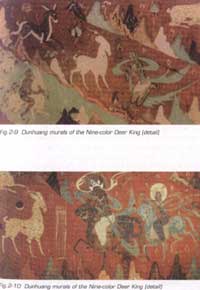 Construction of the Mogao Grottos began in 366 and reached a peak in the Tang Dynasty (618-907), but it was not finished until the Yuan Dynasty (1279-1368). By Emperess Wuzetian’s reign in the Tang Dynasty, more than 1000 grottos had been hewn into mountain slopes there. Today, some 7,000 caves with 492 grottos remain extant in Dunhuang. The complex contains the earliest carved grotto in China. No other grottos in China have experienced a longer period of construction and have a richer content. The entire Mogao Grottos extend for 1,600 meters, and are enshrined with more than 50,000 literary documents and 45,000 square meters of murals drawn over a period that encompassed ten dynasties from the Frontal Qin Dynasty (351-394) to the Yuan Dynasty. It also features 245 colored clay sculptures, and five wooden architectural structures of the Tang and Song (907-1279) dynasties. If we put all the murals of the Dunhuang Grottos together, they would form a 25-kilometerpainting corridor, which is unique in the world.
Construction of the Mogao Grottos began in 366 and reached a peak in the Tang Dynasty (618-907), but it was not finished until the Yuan Dynasty (1279-1368). By Emperess Wuzetian’s reign in the Tang Dynasty, more than 1000 grottos had been hewn into mountain slopes there. Today, some 7,000 caves with 492 grottos remain extant in Dunhuang. The complex contains the earliest carved grotto in China. No other grottos in China have experienced a longer period of construction and have a richer content. The entire Mogao Grottos extend for 1,600 meters, and are enshrined with more than 50,000 literary documents and 45,000 square meters of murals drawn over a period that encompassed ten dynasties from the Frontal Qin Dynasty (351-394) to the Yuan Dynasty. It also features 245 colored clay sculptures, and five wooden architectural structures of the Tang and Song (907-1279) dynasties. If we put all the murals of the Dunhuang Grottos together, they would form a 25-kilometerpainting corridor, which is unique in the world.
The first painter of the Dunhuang Murals was a monk named Lezun. To create paintings on the coarse Surface of the rocks, the artists first applied grass and clay on the roofs and walls of the caves and then began painting. Several clay figures were created later to accompany the paintings. The largest mural in the grotto is 40 meters long and 30 meters wide, and the smallest less than one square meter.
Most of the Dunhuang Murals depict Buddhist stories. For example, in No. 257 Grotto, there is a mural drawn in the Northern Wei Dynasty depicting the Buddhist story “Nine-Color Deer Script.” The Nine-color Deer came upon a river and saved Diao Da who was drowning. Later the Queen urged the King to skin the Nine-color Deer to make a garment for her. When the King’s soldiers were searching for the Nine-color Deer, Diao Da betrayed the Deer’s whereabouts. Diao’s ingratitude for the Deer’s kindness was punished; the Nine-Color Deer was allowed by the King to go back to the mountain. The story is painted in nine scenes, with most animal and human figures drawn in profile; no wrinkling and rubbing skills were used to paint the background mountains and rivers. The strokes of the painting are of great strength, the colors are bright, and the shapes of the figures are decorative. Deep colors are used to draw the Outlines, and the color becomes lighter in the middle section. The brightest parts were pointed with white powders to make it look more three-dimensional.(Fig.2-9) (Fig.2-10)
The Dunhuang Murals contain rich designs of Buddhas, deities, ghosts, animals, mountains, rivers, architecture and a few decorative patterns. It is a splendid treasure of Buddhist art. The murals present the painting styles and features of different dynasties, imitating the W6stRegions at first but drawing more on the Han styles as time went on. In the Dunhuang Murals, we can see directly the development of mural art over ten dynasties and get rich information about many aspects of Chinese Culture and history.
Something of Huashan
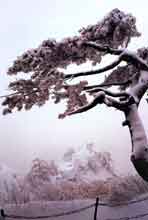 Huashan is situated in Huayin county, Shaanxi province, with the Wei River to its north, and Qinling Mountains to the south. Its main peak is over 2200 metres above sea level. Standing in a circle and confronting each other, Huashan East, South, West, North and Central Peaks resemble a colossal lotus flower in full blossom.
Huashan is situated in Huayin county, Shaanxi province, with the Wei River to its north, and Qinling Mountains to the south. Its main peak is over 2200 metres above sea level. Standing in a circle and confronting each other, Huashan East, South, West, North and Central Peaks resemble a colossal lotus flower in full blossom.
Incidentally, in ancient Chinese phraseology, Huashan was also taken to mean Flower Mountain. Ever since ancient times, Huashan is noted for being extremely magnificent and precipitous. There is only one perilous passage to the summit.
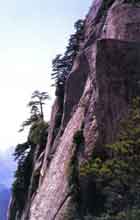 Yuntai Peak (North Peak):
Yuntai Peak (North Peak):
In laojunli gorge area, the path to the top consists of some 570 steps with the steep cliffs on the one side and the fathomless ravine on the other. The steel chain along the path gives the mountain climbers an indispensable aid. With all its three sides being perilous cliffs, the North Peak has its only way out via the south ridge.
Qingkeping:
It is at a distance of 10 km from the mouth of Huashan’s valley. There the path twists and turns, ups and downs between the grotesque cliffs, and the mountain streams course their way about merrily, but now and then, all of a sudden, lose its height to form a dashing water-fall with roaring sound.
Lianhua Peak (West Peak):
A spectacular peak rises vertically into the sky. Viewed from its top, the terrains of Shanxi and Gansu spread boundlessly, and Wei and Luo Rivers thread their ways across them like two silver ribbons. In front of the Peak, reposes a green dragon-shaped ridge called “Cengling”. The Peak’s west side is a precipitous cliff, while the east side is a steep rocky slope with a secluded dense forest close by. On the top of the peak, stands a temple, with a huge rock shaped like a lotus flower in front.
Chaoyang Peak (East Peak):
A fantastic sight too. On its top, there is the “Sun Platform” for viewing the sun rise. About 700 metres away in the west direction, Luoyan Peak (Fallen Wild Goose Peak) with perilous cliffs and tall pine trees, towers. Looking southward, the Qinling Mountains with its high and low ridges and peaks ripple like a vast sea. Looking downward, there is a vast expanse of plain, and the rivers, now hidden and now visible are winding their way across the land.
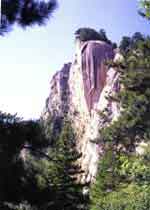 Luoyan Peak (South Peak):
Luoyan Peak (South Peak):
It is 2100 metres above sea level, the highest peak of Huashan. On its top, is a water pond called some exquisite inscriptions. Only travellers reaching here can claim they’ve arrived at the real peak of perfection. Around, a fantastic view presents itself before the eye: drifting sea of clouds hanging over crowded peaks and ridges in the west; 800 Li flat land of Central Shanxi Plain in the north, and to the east the Yellow River in Tongguan area like a floating ribbon coming from a far.
Daming Lake
 Daming Lake (Lake of Great Light) Located in the northern part of the Old City district, this lake has a surface area of 46.5 hectares, which is roughly one quarter of the district’s total area. It is one of Jinan’s three major tourist spots. The pavilions, kiosks, terraces, halls and temples that dot the shore or the surrounding hills have all been repaired and repainted. A children’s playground, a rollerskating rink and flower house have been constructed and facilities for boa-ting have been installed. Furthermore, the waters of the Five-Dragon Pool have been diverted to this place to form an artificial spring, whose flow turns into a beautiful cascade on the west bank. The shores are fringed with weeping willow and over 100 mu (about 16 acres) of the lake have been planted to white lotus, restoring the traditional scene of “lotus on four sides and willow in three”.
Daming Lake (Lake of Great Light) Located in the northern part of the Old City district, this lake has a surface area of 46.5 hectares, which is roughly one quarter of the district’s total area. It is one of Jinan’s three major tourist spots. The pavilions, kiosks, terraces, halls and temples that dot the shore or the surrounding hills have all been repaired and repainted. A children’s playground, a rollerskating rink and flower house have been constructed and facilities for boa-ting have been installed. Furthermore, the waters of the Five-Dragon Pool have been diverted to this place to form an artificial spring, whose flow turns into a beautiful cascade on the west bank. The shores are fringed with weeping willow and over 100 mu (about 16 acres) of the lake have been planted to white lotus, restoring the traditional scene of “lotus on four sides and willow in three”.
Mount Tai
 Towering in the middle of Shandong Province, and stretching into the sea, the magnificent range of Mount Tai rises and falls for over 200 kilo-meters just like a giant sleeping dragon. with the Yellow River flowing at the foot of its northern slopes, it has been regarded as the first of the five sacred mountains in ancient China for its ma-jesty and beauty. Its summit,Jade Emperor Peak, is 1,545 meters above sea level and is known as the Celestial Pillar. Overlooking the other smaller peaks, it offers a breathtaking pano-ramic view. In ancient times, Mount Tai was deified by the feudal rulers of various dynasties and given the title, “Divine Emperor of the East Peak”.
Towering in the middle of Shandong Province, and stretching into the sea, the magnificent range of Mount Tai rises and falls for over 200 kilo-meters just like a giant sleeping dragon. with the Yellow River flowing at the foot of its northern slopes, it has been regarded as the first of the five sacred mountains in ancient China for its ma-jesty and beauty. Its summit,Jade Emperor Peak, is 1,545 meters above sea level and is known as the Celestial Pillar. Overlooking the other smaller peaks, it offers a breathtaking pano-ramic view. In ancient times, Mount Tai was deified by the feudal rulers of various dynasties and given the title, “Divine Emperor of the East Peak”. 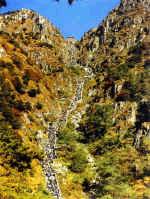 From the First Emperor of the Qin Dynasty down to Em-peror Qianlong of The Qing Dynasty, many of them personally visited Mount Tai to attend grand sacrificial ceremonies. Various other titles were lavishly offered to the “Divine Emperor of the East Peak” by them as a means to have their own names long remembered. These “royal visits” contributed to the construction of many temples, pavilions, and other buildings.
From the First Emperor of the Qin Dynasty down to Em-peror Qianlong of The Qing Dynasty, many of them personally visited Mount Tai to attend grand sacrificial ceremonies. Various other titles were lavishly offered to the “Divine Emperor of the East Peak” by them as a means to have their own names long remembered. These “royal visits” contributed to the construction of many temples, pavilions, and other buildings.  Not only emperors but poets, scholars and men of letters were fond of coming to this sacred mountain, and left behind countless inscriptions engraved on rocks and stones. It many be said that the whole of Mount Tai is a vast open-air mu-seum of history, having on display much of an oriental civilization, which is representative of the creative wisdom of the ancient Chinese people.
Not only emperors but poets, scholars and men of letters were fond of coming to this sacred mountain, and left behind countless inscriptions engraved on rocks and stones. It many be said that the whole of Mount Tai is a vast open-air mu-seum of history, having on display much of an oriental civilization, which is representative of the creative wisdom of the ancient Chinese people.
Jinan
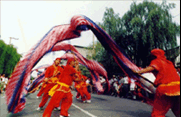 Jinan, capital of Shandong Province on China’s east coast, is the province’s political, economic and cultural center. Jinan has juris-diction over five districts (Lixia, Licheng, Hua-iyin, Tianqiao and Shizhong), four counties (Changqing, Pingyin, Shanghe and Jiyang) and Zhangqiu City, with a total area of 8,227 sq. km and a population of 5.49 million, including 2.54 million urban people. Located in the western part of the center of Shandong Province, Jinan is at the juncture of the Beijing-Shanghai and Qingdao-Jinan railways. Nearby to the south is Mount Tai, officially recog-nized by the United Nation as part of the world’s natural and cultural heritage. To the north is the Yellow River, which is called the “cradle of the Chinese nation.” With a warm-temperate continental monsoon climate and clearcut seasonal changes, Jinan has an average annual tempe-rature of 14 C and an annual mean precipitation of 650-700 mm. Thanks to its long history, Jinan has been designated by the State Council as a famous historical and cultural city. As Jinan boasts a number of natural springs amid pictures-que scenery, it is known as the “City of Springs.” The city tree of Jinan is the willow, and the city flower is the lotus.
Jinan, capital of Shandong Province on China’s east coast, is the province’s political, economic and cultural center. Jinan has juris-diction over five districts (Lixia, Licheng, Hua-iyin, Tianqiao and Shizhong), four counties (Changqing, Pingyin, Shanghe and Jiyang) and Zhangqiu City, with a total area of 8,227 sq. km and a population of 5.49 million, including 2.54 million urban people. Located in the western part of the center of Shandong Province, Jinan is at the juncture of the Beijing-Shanghai and Qingdao-Jinan railways. Nearby to the south is Mount Tai, officially recog-nized by the United Nation as part of the world’s natural and cultural heritage. To the north is the Yellow River, which is called the “cradle of the Chinese nation.” With a warm-temperate continental monsoon climate and clearcut seasonal changes, Jinan has an average annual tempe-rature of 14 C and an annual mean precipitation of 650-700 mm. Thanks to its long history, Jinan has been designated by the State Council as a famous historical and cultural city. As Jinan boasts a number of natural springs amid pictures-que scenery, it is known as the “City of Springs.” The city tree of Jinan is the willow, and the city flower is the lotus.
Baotu Spring
 Baotu Spring, or Jet Spring, is known not only as the first of the 72 springs in Jinan but as the “First Spring Under Heaven”. Together with its environs, it has been turned into a park of the same name that is now one of the three major places of interest in Jinan. Baotu Spring is in the southwestern corner of the Old City district. It used to occupy only 4 mu of land (two thirds of an acre), but since liberation the People’s Government has expanded the grounds to over 50 mu, or about 9 acres. All the old buildings and relics here have been restored, the springs and ponds have been thoroughly dredged, and the banks lined with stone. Lawns and rockeries have been built and numerous trees and flower planted.
Baotu Spring, or Jet Spring, is known not only as the first of the 72 springs in Jinan but as the “First Spring Under Heaven”. Together with its environs, it has been turned into a park of the same name that is now one of the three major places of interest in Jinan. Baotu Spring is in the southwestern corner of the Old City district. It used to occupy only 4 mu of land (two thirds of an acre), but since liberation the People’s Government has expanded the grounds to over 50 mu, or about 9 acres. All the old buildings and relics here have been restored, the springs and ponds have been thoroughly dredged, and the banks lined with stone. Lawns and rockeries have been built and numerous trees and flower planted.
Temple of the God of Taishan Mountain (Dongyuemiao)
The Temple of the God of Taishan Mountain stands on Shenlu Street in the Chaoyang District. It is said that the temple was built as a place of worship for the Supreme Celestial Emperor of Taishan Mountain, one of the five sacred mountains of China.
The temple was first built in the Yanyou period (1314-1320) of the Yuan Dynasty at which time it was one of the largest Daoist temples in the capital, and the first major temple in northern China belonging to the Zhengyi Sect of Daoism founded by Master Zhang Daoling. A glazed memorial archway inscribed with “In Reverence to the God of Mount Tai” stands at eh temple’s front entrance.
The temple complex is composed of three courtyards. The main courtyard contains three halberd gates (jimen), the Hall of the Taishan Mountain (Daizongbaodian), and the Hall of Moral Cultivation (Yudedian).
In the center of the Hall of the Taishan Mountain are statues of the God of Taishan Mountain and his high-ranking attendants. The two corridors in front of the hall house 72 statues of deities, or “Chiefs of Departments,” each representing some form of human activity or natural force.
There are more than 100 stone tablets dating from the Yuan, Ming and Qing dynasties in the temple compound. The most valuable is a four-meter-high stela inscribed, “Tablet of the Daoist Master Zhang” in the handwriting of the Yuan Dynasty calligrapher Zhao Mengfu.
The temple was burned down in a battle during the last years of the Yuan Dynasty and was rebuilt in 1449 during the Ming Dynasty. The buildings standing today date from the Qing Dynasty, though they retain the style of the Yuan and Ming periods.
Some Places of Taishan
Taishan lies in Tai’an county in the middle of the Shandong Province, encompassing an area of 426 square kilometers. Its summit, 1546 meters above sea level, has a vertical height of over 1200 meters above the ground. Magnificent ancient architecture and historical and cultural sites can be found over hill and dale, and along the mountain passages. UNESCO has listed Mount Tai as ” A World Cultural and Natural Heritage.”
The temple of Taishan:
With the Hall of Celestial Gifts as its main structure and axis, and encircled by a corridor, it covers an area of 96,500 square meters.
With the Drum Tower and the Bell Tower as its two wings facing each other, the crenellated Temple has yellow glazed-tile roofs and red ridges, and a pavilion at each of the four corners. Old sky-piercing cypresses and steles spread all over the place, in addition to the cultural relics like the cast-iron pavilions and towers.
The Hall of Celestial Gifts:
The yellow glazed-tile roofed and double-eaved Hall, 22.3 meters in height, consists of 9 rooms stretching 48.7 meters long east to west, and 19.8 meters wide. It has a stone terrace with carved parapets. The mural on the wall of the Hall measuring 62 meters long and 3.3 meters high, depicts the God of Mount Tai on an inspection tour. The eastern part of the mural illustrates ” Setting Off on the Tour”, while the western part, “Returning to His Palace”. The main contents are descriptions of the ceremonious processions on the tour, interspersed with rare and precious birds and animals, while mountains, rivers, forests, towers, pavilions, halls are used as backgrounds. The mural is grand in scale, well-knit in layout and smooth in brush work.
The Gate to Mid-heaven:
It’s located at the mid-point of the mountain path to the top, where one has a splendid view of the vertical steps to the summit, the Wen River like a ribbon in the south, Zhongxi Mountain in the east, and the Fenghuang Ridge in the west.
Eighteen Bends:
In barely one kilometer length, the perilous trail has to elevate itself to a vertical height of 400 meters. One has to scale 1594 stone steps to reach Shengxianfang (Archway) meaning a person passing through the Archway will immediately become a celestial being. Beyond the Archway, the passage winds along craggy cliffs and grotesque rocks. Ascending to the South Gate to Heaven, one sees the Eighteen Bends merely as a vertical stairway hanging in the air, upon which the climbers are moving up like little ants. It’s a model in Chinese architecture on the mountains, utilizing scenery to enhance their brilliancy.
The Confucius Tourism Zone
Qufu, hometown of the great thinker and educator Confucius, is listed in the first group of national famous cities of historical and cultural relics designated by the State Council. The first Chinese general history book Shiji (History) gives that it is the hometown of Shen Nong (God of agriculture), Huang Di, Shao Hao and Mencius, and has been the site for ancient states and capitals like the Shang dynasty, the Yin State, the Lu State, etc. In the city, there are now 112 key historic relics under protection, among which four sites are of national level, twelve are of provincial level. The Confucian Temple, the Confucian Mansion and the Confucian Cemetery were ranked as one of the world cultural heritage in 1994.
The Confucian Temple, also known as the Most Sage Temple, was the place for ancient emperors to offer sacrificial sercives to Confucius. Located in the center of Qufu City, the Confucian Temple, an oriental style complex with a long history, is known as the “only case” in the history of the world architecture, and is considered one of the three most famous traditional architectural complexes in China, the other two being the Forbidden City in Beijing, Summer Hill Station of Chengde. It entered the list of the first group of national level key historic relics, and was ranked as a world cultural heritage. The second year after Confucius’death, Aigong, Duke of the state of Lu ordered to turn the former residence of Confucius into a memorial hall to offer sacrificial services every year. It used to have only 3 rooms, in which the utensils, such as clothes, hats, the chime stone, the carriage and books once used by Confucius were preserved. To consolidate their ruling positions, rulers of the successive dynasties showed great respect for Confucius and made a point of rebuilding the temple. The expansion of it started from Sui Dynasty, and in Tang Dynasty, it had 30 halls and chambers. The present size of the temple was established after many rebuildings and expansions in the Hongzhi Period in Ming Dynasty. With a span of 1 kilometers from the south to the north, the temple covers an area of 21.8 hektares. Being an imitation of the imperial palace in its architecture, the temple has 9 courtyards opening off off one another made up of 104 buildings, 446 rooms, and 1250 ancient trees. The halls and other buildings in the temple looks resplendent, magnificent and imposing. Having over 2,000 carved relics in the temple, it is one of the largest collections in the country.
Located in the center of Qufu, next to the Confucian Temple, the Confucian Mansion (also known as the Mansion of Duke of Yansheng) was the residence for Confucian descendants, the largest and grandest feudal noble mansion preserved to this day in China. The mansion arranged in three parts has 9 courtyards opening off one another and 463 halls, towers, and verandas, and covers a total area of 16 hectares. In the front part of it lie the official buildings, the middle part the residence, and the back the garden. After the death of Confucius, his decedents have always been living next to the Confucius Temple. An official building was established in Song Dynasty, and in Ming Dynasty, the Mansion of Duke of Yansheng was built. After many times of rebuilding and expansion, it has turned into a typical feudal noble mansion combining official buildings with a residence.
Located in the north of Qufu, the Confucian Cemetery (also known as the Cemetery of the Most Sage Master), is the graveyard for Confucius and his posterity. In the cemetery are clusters of tombs-over 100 thousand tombs since the Zhou Dynasty, groups of tombs of the descendants of the sage and forests of steles, and 400 tombstones. The Confucian Cemetery is also a botanical garden, as there are over 42,000 trees in it, and the planting of trees in it started 2,400 years ago. After Confucius death in 479BC, most of his descendants and clansmen were buried in the cemetery, so it has been expanding ever since. It covered an area of 1,800 mu in late Ming Dynasty and 2941.9 mu in the 23rd year of Kangxi Period in Qing Dynasty. At present, the wall boarders the cemetery extends about 5591 meters, and the cemetery itself covers an area of 183.33 hectares.
It takes roughly a day to visit the three major spots in Qufu. After their arrival, the tourists can visit Confucian Temple first (which takes two and a half hours), then Confucian Mansion (two hours). Getting out of Confucian Mansion, they can take a traditional-styled carriage and visit Confucian Cemetery (three hours). They can also visit Yanhui’s Temple and the Arch of Longevity on the way to the cemetery.
The major annual touring activities in Qufu include: International Festival of Confucian Culture, Study Tour to Confucius’ Homeland, Touring around the States in Confucius’ Route, Calligraphy Exhibitions, etc. The international Festival of Confucian Culture is held from September 26th to October 10th each year, during which a grand opening ceremony and ancient sacrificial dances and musical performances will be put on.
The climate of Qufu is temperate, continental and seasonal, which has a clear distinction between the seasons. In spring, it is dry and windy; in summer hot and rainy; in autumn mild and cool; in winter cold and dry. Its average annual temperature is 13.6oC; the lowest ¡§C18.1oC; the annual rainfall 666.3mm. Qufu’s elevation is 60.1 meters.
First Aid Telephone Number: 120;
Traffic Aid: 122;
Telephone number to request: 0537-4414002
The best season to visit Qufu is from April to November.
The major sight spots neighbouring Qufu are Mount Tai, Baotu Spring and Daming Lake in Jinan, Liangshan Mountain, Mencius’ Homeland-Zoucheng City, etc. Many buses go forth and fro between Qufu and those places.
Transportation in Qufu is very convenient. Air passengers can take off the plane at Jinan or Xuzhou, and then take long distance buses to Qufu; Train passengers can change their trains at Yanzhou, arrive in Qufu in 15 minutes. In Qufu, tourists can take taxies, traditional-styled carriages, tricycles, buses to go around. The prices for these means of transportation are inexpensive.
1.The major souvenirs tourists can buy in Qufu include Wooden Carvings (Confucius’ Statue, Ruyi, Walking Stick, etc.), Inkstone made of stones from Nishan Moutain, Sesame Oil of Confucian Style, Sesame Food of Confucian Style, Liqor of Confucian Mansion, Qufu Beer, Fragrant Rice, etc. There are store selling those products all around Qufu, including the appointed ones. The prices are favourable.
2.The major hotels in Qufu include: Queli Hotel (3 star), Xingtan Hotel (2 star), Tourism Hotel (2 star), Qufu Hotel (2 Star), Kongfu (Confucian Mansion) Hotel, Mengfu (Mencius’) Mansion Hotel and Qufu Restaurant, etc. The local special dishes include Kongfu-(Confucian Mansion)styled Banquet (including different arrangements for family reunion, wedding, and birthday banquets), and smoked Doufu (bean curd), Konfu (Confucian Mansion) battercake are the main typical local snacks.
Tai Shan: One of the Five Sacred Taoist Mountains
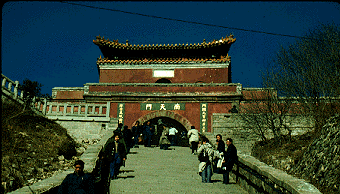 The last gate before heaven, located at the top of the main route.
The last gate before heaven, located at the top of the main route.
Tai Shan and Imperial Rituals:
Known as the Mount of the East, the Mountain of the Gods, and the Eastern Peak of Heaven, Taishan rises 1,545 meters above the city of Tai’an in Shandong province, the tallest of a mountain range covering 426 square kilometers. According to myths, Mount Tai, the easternmost of the five sacred Taoist mountains, is governed by the Grand Emperor of the Eastern Peak who rules earth and men. During the first centuries of the Christian era he became briefly associated with the world of the dead. Temples house images of the Grand Emperor of the Eastern Peak sitting in formal imperial costume. His daughter is the Princess of Multi-Colored/Azure Clouds (Bixia), worshipped by peasant women as their protectress.
The emperor’s ascent of Taishan bonded the deities with the dynasties. During the Xia, Shang, and Zhou dynasties 72 monarchs trekked to Taishan to pray, only five reaching the top. All constructed temples, erected stone calligraphy tablets, composed and commissioned poetry and artwork. The Dai Temple, Wangmu Pool, Hongmen Palace, Zhongtianmen – South Heavenly Gate, and the Bixia Temple evidence the traces of these leaders. The feng and the shan, two sacrifices executed by the Emperor on Taishan, symbolized the heavenly approval of the Emperor’s deeds and his dynasty. The Emperor prayed to Heaven in the feng sacrifice and to Earth in the shan sacrifice. Heaven would never allow an unworthy sovereign to ascend Taishan. Doubtful emperors urged by their court to go to Taishan feared Heaven’s wrath. The legendary Emperor Shun had performed the feng and shan sacrifices around 2255 – 2205 BC . Emperor Shih Huang Ti of the Qin Dynasty had attempted the two sacrifices, but fled in violent storms. Wu Ti of the Han Dynasty revived the forgotten rites, performing the sacrifices in 110 BC, 106 BC, and 98 BC. The Late Han Dynasty Emperor Kuang-wu reluctantly made the sacrifices in 56 AD. Wen Ti, Emperor of the Sui Dynasty, begged pardon from his faults, performing smaller sacrifices to Heaven at the foot of Taishan in 595. Tai-tsung, the second emperor of the Tang Dynasty, failed in each of his three efforts. On new year’s day 666 Tai-tsung’s son, Kao-tsung, completed the feng and shan sacrifices for the first time in 610 years. His wife, Empress Wu, set the precedent as a woman participant, aiming for proof of her virtue. Eventually, rulers forgot the imperial feng and shan sacrifices, but not Taishan itself.
The foot to the summit of Taishan measures 24 kilometers, traversed by cablecars, minibuses, buses, and over 6,000 stone steps. Three main gates mark the pathway – I Tianmen, Zhongtianmen, and Nantianmen (First, Second, and Third Heaven Gates) with three guesthouses – Taishan, Zhongtianmen, and Shenqi – welcoming travelers. Two main paths lead up the mountain, converging at Zhongtianmen. The lesser traveled western route boasts few structures. The central route chronicles China’s past through temples, calligraphy stones, and historic memorials. Vendors crowd the mountain path, announcing the new era of China.
Taishan Mountain in Shandong Province
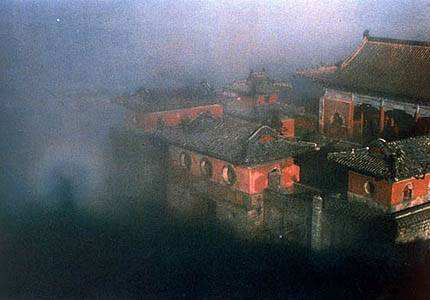 Extracted from World Heritage Network of China in May 2001.
Extracted from World Heritage Network of China in May 2001.
Taishan Mountain in Shandong was included as “World Cultural and Natural Heritage” by UNESCO in Dec 1987.
Taishan Mountain, a typical representative of the Chinese famous traditional mountains, is a mountain with a long history and a special historic status. In 1982, Taishan Mountain was up into the list of State key scenic spots and was formally listed in the directory of World Natural and Cultural Heritage in 1987. It becomes a precious heritage of human being.
Taishan Mountain locates in the east of North China Plain and the middle of Shandong province erecting from the Shandong hills. It is prominent around other hills. The prominent peak, Yuhuang peak, is 1545 meters high and locates in east 117.6 degree, north 36.16 degree. The south of Taishan Mountain is higher than the north. Its south foot of mountain begins from Tai’an city and its north foot of mountain stops in Jinan City, the distance between which is 60kms. In Taishan Mountain, the transportation is convenient with the Jinghu railway passing by in the west. In its north is Jinan city, which has another name of “spring city”. The distance between Taishan Mountain and Qubu is 70kms. Many roads and railways such as Taifei, Taixin, Taining, and Taiji meet in Tai’an city, which just locates in the south of Taishan Mountain.
Taishan Mountain is in a superior geographic location with abundant water and thermal resources, and its climate belongs to the warm temperate zone half wetness monsoon climate. As regard to its historic position, in the ancient times, Taishan Mountain is a developed region – in the lower reaches of the Yellow River. As regard to its cultural position, it is the center of Dongyi culture. In the south foot of Taishan Mountain, there is Da Fenkou culture, and there is Longshan Culture in its north foot, it is the center of Qi and Lu. And its transportation is more superior. Taishan Mountain is in a key position where the railway from central plains to Shandong peninsula meets the railway connecting the south and north of the east coast. There are no hills between Taishan Mountain and the capitals in the ancient times as well as the developed regions. This superior condition helps Taishan Mountain gain the first position among the Five Famous Mountains in China.
As a mountainous scenic spot, Taishan Mountain has high values in term of aesthetics and science, especially the aesthetic value, which is the foundation for Taishan Mountain becoming a famous mountain in the history and the world natural and cultural heritage today. For thousands of years, during the process of studying on Taishan Mountain in terms of adoration, taste, religion and science, the people has created extremely abundant and valued Taishan scenic culture. Moreover, in the Taishan scenic culture, the natural scene plays the key role with the literacy scene assisting. The nature and culture penetrate into each other. Here we can see the philosophy, aesthetics and science idea about the harmonious development of Sky, Ground and Human beings. Thereby, either from the point of time or space, Taishan Mountain contains extremely abundant contents with high aesthetic, science and historic value. We can say that Taishan Mountain is the symbol of spiritual culture of China and the unique heritage of the world.
Penglai, Land of Fairy Tales
Penglai County in East China’s Shandong Province is a place of fairy tales.
The ancient coastal castle of Penglai, about 65 kilometres northwest of Yantai, is the abode of the gods, according to mythology.
The legend of the Eight Immortals Crossing the Sea originated here. And the famous vision or mirage, which locals claim appears every few decades, has given a fascinating and mysterious atmosphere to the place.
Ever since I was a child I had dreamed of visiting Penglai. On a sunny morning in May, I finally made the trip.
Sainted mountains
Peng Lai Ge (Penglai Pavilion) is perched on a cliff overlooking the sea. It is about 1,000 years old.
The castle is on one of the three sainted mountains inhabited by immortals. The other two are Yingzhou and Fangzhang. They have frequently been visited by emperors since the Qin (221-206 BC) and the Han (206 BC-AD 220) dynasties.
It is said that the eight immortals got drunk at the castle and crossed the sea using magic, without ships.
Their magic inspired a popular saying: “When the Eight Immortals cross the sea, each one shows his special feat. Each tries to outwit the other.”
Today the saying means that everybody has his or her own way of dealing with things.
Penglai Pavilion was built in 1061 during the Northern Song Dynasty (960-1127).
On display in the complex are works of calligraphy from famous writers, couplets on the hall columns and stone inscriptions.
“Penglai has many folk customs,” said our tour guide Dai Fali.
“The most famous is the traditional fair of Penglai Pavilion held on January 16, according to the lunar calendar at the Heavenly Queen’s Palace.”
The Heavenly Queen is also called Mazu in Fujian Province. According to mythology, she was the daughter of Lin Yuan, inspector of Putian, Fujian in the Song Dynasty (AD 420-479). Her name was Lin Mo.
It is said she was born with red lights and fragrance, and seldom cried. She helped the poor, warded off devils and saved endangered fishing boats.
When Lin died at the age of 19, she became the Goddess of the Sea. Because she blessed ships at sea, people in Fujian offered her sacrifices.
On January 16, which is said to be her birthday, the people of Penglai hold a fair. They dance the yangge (a popular rural folk dance), play with dragon lights and walk on stilts.
Optical illusion
While visiting Penglai, I met a family from Hangzhou. When I asked them why they had come, the mother said: “For the mirage, of course.”
Because Penglai sits on the southern tip of the Bohai Straits, the low temperature of the sea water and the high temperature along the coast result in the appearance of spectacular optical illusions.
Usually they occur during summer and autumn, especially after it rains and when it is overcast and misty.
Cultural treasures
Penglai Pavilion is a place to which men of letters have flocked over the centuries. They left behind them inscriptions on tablets.
Among these is an engraved essay entitled “Notes on Reading Wu Daozi’s Painting,” by the poet Su Shi during the Song Dynasty (960-1279).
The inscription of the essay entitled “Watching the Mirage on the Tower on a Summer’s Day” is by Dong Qichang, a Ming Dynasty (1368-1644) calligrapher.
This ancient heritage adds a tint of history and culture to the mountains and sea.
“Penglai people are proud to meet so many famous poets and calligraphers here, who have brought cultural wealth to the area,” Dai said.
The “Hai Bu Yang Bo” (Placid Seawater) board was written by Lu Qiguang, a Qing calligrapher. During the Sino-Japanese war in 1895, the word bu was struck by a cannonball that failed to explode.
“The sea churned and wars began,” Dai explained. “If the bomb had exploded, we would not have the Penglai Pavilion today.”
Defiant spirit
East of the castle of Penglai is the Penglai water city, with dry docks and piers.
Construction of the fortress began in 1042. It was completed in 1696. The water fortress is the earliest man-made ancient military port in the country. Along with the castle of Penglai, it is a key historical relic under State protection.
National hero Qi Jiguang of the Ming Dynasty (1368-1644), a native of Penglai, once trained his naval force here against foreign invasion.
Listening to the story of Qi, I felt as if I could almost see him leading thousands of soldiers on the fortress.
There we saw ancient warships found from the port of the fortress, which are left at the site to remind us of his defiant spirit.
In the past 600 years, the Qis have donated many cultural relics, such as the Qi Jiguang Statue and the Father-son Governor. The Former Residence of Qi Jiguang, which is under construction, will open to visitors next year.
Tianheng Hill
West of the castle is Tianheng Hill or Dengzhou Cape, the southern end of the border between the Yellow Sea and the Bohai Sea.
Legend has it that it used to be the fort for the Tianheng 500 heroic men, who built camps on top of the barracks overlooking the sea.
Tian Heng, a Qin Dynasty general, used to station troops there. During the Ming and Qing dynasties, cannons were placed here. In the 1940s, the People’s Liberation Army used them to attack Japanese warships.
The relics are still there, but other aspects of the site have changed, with a new cultural park and a plank road along the cliff.
Walking on it with clouds surrounding me, I could not help but think that the new road would have made the sea crossing much easier for the Eight Immortals.
Travel tips
Five flights every day take off from Shanghai Pudong International Airport to Yantai Airport and the flight takes about one hour. Or tourists can take Train No. 2582 departing from Shanghai Railway Station at 9:40am and arriving at Yantai at 7:00am. There they can take buses to Penglai. The bus departs every 15 minutes.
Wuxi
Situated in the southeast of Jiang-su Province, Wuxi borders the Taihu Lake on the south and the Yangtze River on the north. Beijing-Shanghai railway goes across the city from the west to the east and the age-old Grand Canal winds though if from the north to the south. Wuxi is always termed as the “Land of rice and fish” for its prosperous economy, culture of long standing ,fertile land and rich products.
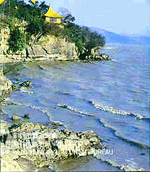 Lake Taihu is one of China’s five biggest fresh water lakes, and Wuxi,one of the cities around the lake, is referred to as a “Radiant-Pearl”on the lake.Wuxi boasts a dragon boat,2 imperial boats, a speed boat and many other pleasure boats which make Lake Taihu tour a most enjoyable one.
Lake Taihu is one of China’s five biggest fresh water lakes, and Wuxi,one of the cities around the lake, is referred to as a “Radiant-Pearl”on the lake.Wuxi boasts a dragon boat,2 imperial boats, a speed boat and many other pleasure boats which make Lake Taihu tour a most enjoyable one.
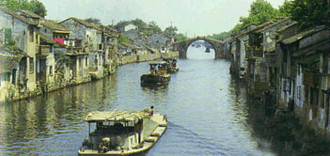 Wuxi is blessed with convenient transport and communications for travel. The Beijing-shanghai Raiway ,The ancient Grand Canal and a network of highways make the city easily accessible. Also available is the Wuxi airport, 20 kilometers away from the city center, which links the city with Beijing, Fuzhou, Fushan and Huiyang and other cities of tourist attraction throughout the country.
Wuxi is blessed with convenient transport and communications for travel. The Beijing-shanghai Raiway ,The ancient Grand Canal and a network of highways make the city easily accessible. Also available is the Wuxi airport, 20 kilometers away from the city center, which links the city with Beijing, Fuzhou, Fushan and Huiyang and other cities of tourist attraction throughout the country.
Nanjing
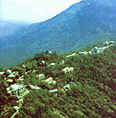 Lacated at the eastern part of China, Nanjing is the capital of jiangsu Province which is developed in economy in China and an important central city on the middle and lower reaches of the Yangtse River.
Lacated at the eastern part of China, Nanjing is the capital of jiangsu Province which is developed in economy in China and an important central city on the middle and lower reaches of the Yangtse River.
Nanjing is situated on the vast plain of the lower reaches of the Yangtse River and at 32°03’N, 118°47’E. It belongs to the northern subtropical monsoon climate zone where the four seasons are clearly demarcated, the annual mean temperature is 16¡æ, the annual even precipitation is 1,106 mm and the frost-free period is 237 days.At present, Nanjing has jurisdiction over 10 districts and 5 counties,covering an area of 6,516 square kilometres and having a population of about 5,200,000. Nowadays, Nanjing has developed into a multipleproducing industrial base in eastern China, an important hub of transportation and communication center, one of China’s four major scientific research and edu-cational central cities. The gross national products of the whole city in 1995 amount-ed to 58 billion yuan, a 12% increase over the previous year.
Zhouzhuang
 Zhouzhuang is well known for its beautiful environment and simple architecture.Although more than 900 years have past,its architectural style is still well preserved.More than 60 percent of the residential houses were built during the Ming (1368-1644)and Qing(1644-1911)dynasties,consisting of nearly 100 classic courtyards and 60 carved brick archways. Like a lotus on the water ,the town is surrounded and bisected by rivers including Nanbeichi ,Houxiang, Youcheyang and Zhongshi . There are many bridges as well, including Fu’an, Zhenfeng, Fuhong, Tong-xiu, Puqing, anyuan, Tiyun, Bao’en, Longxing, Yong’an, Shide, Quangong, Qinglong, Xianhong and Jubao,the most famous being Yong’an and Shide,known as Double Bridge,one a stone arch type and the other a stone beam type bridge.Two rivers crisscross in north-south and east-west directions here,and the square and round openings of the bridges provide a unipue frame for the water scenery.
Zhouzhuang is well known for its beautiful environment and simple architecture.Although more than 900 years have past,its architectural style is still well preserved.More than 60 percent of the residential houses were built during the Ming (1368-1644)and Qing(1644-1911)dynasties,consisting of nearly 100 classic courtyards and 60 carved brick archways. Like a lotus on the water ,the town is surrounded and bisected by rivers including Nanbeichi ,Houxiang, Youcheyang and Zhongshi . There are many bridges as well, including Fu’an, Zhenfeng, Fuhong, Tong-xiu, Puqing, anyuan, Tiyun, Bao’en, Longxing, Yong’an, Shide, Quangong, Qinglong, Xianhong and Jubao,the most famous being Yong’an and Shide,known as Double Bridge,one a stone arch type and the other a stone beam type bridge.Two rivers crisscross in north-south and east-west directions here,and the square and round openings of the bridges provide a unipue frame for the water scenery. 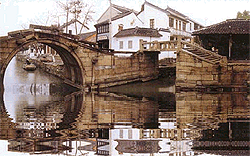 Sitting on the boat,one may enjoying the scene between bridges and feel the interest of a water township which offers a quiet and simple life .When night falls ,all streets are empty. Down the narrow lanes one catches a glimpse of dim lights .Walking by the waterside,along the road or over a bridge ,the peace of the calm water and clear sky, perhaps punctuated oc-casionally by the distant sound of laughter,creates a harmonious and sweet environment.
Sitting on the boat,one may enjoying the scene between bridges and feel the interest of a water township which offers a quiet and simple life .When night falls ,all streets are empty. Down the narrow lanes one catches a glimpse of dim lights .Walking by the waterside,along the road or over a bridge ,the peace of the calm water and clear sky, perhaps punctuated oc-casionally by the distant sound of laughter,creates a harmonious and sweet environment.
Yangzhou
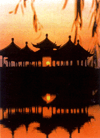 Emperor Qian Long(1736- 1795) of the Qing Dynasty visited Yangzhou every time on the way of his six inspection tours to the south of the Yangtze River. As his majesty took delight in the scenery of mountains and waters, the local officials and salt merchants spared no money in recruiting crackajack workmen and going in for large-scale nstruction, excavating ponds and pilling up rockeries. They had built gardens beautiful and tasteful one after another on either bank of the Slender West Lake. Thus a splendid view rises before us from the Slender West Lakc to Pingshan ll. “Peach blossoms and weeping willows on either mbankment are mirrored in the lake, pavilions and towers stand erect all the way to the hill.” Today, it is here that Yangzhou pre-sents”Emperor Qian Long’s Water Itinerary” tour program.
Emperor Qian Long(1736- 1795) of the Qing Dynasty visited Yangzhou every time on the way of his six inspection tours to the south of the Yangtze River. As his majesty took delight in the scenery of mountains and waters, the local officials and salt merchants spared no money in recruiting crackajack workmen and going in for large-scale nstruction, excavating ponds and pilling up rockeries. They had built gardens beautiful and tasteful one after another on either bank of the Slender West Lake. Thus a splendid view rises before us from the Slender West Lakc to Pingshan ll. “Peach blossoms and weeping willows on either mbankment are mirrored in the lake, pavilions and towers stand erect all the way to the hill.” Today, it is here that Yangzhou pre-sents”Emperor Qian Long’s Water Itinerary” tour program. Cruising has always been a distinctive featurc of Yangzhou travel. The cruise starts from the front of the two quiet and elegant hotels which used to be Qian Long’s imperial garden and temporary palace. Tourists may get on boat at the imperial pier right before the gate of the hotel to sail westward, following the emperor’s footprint to view and admire the pretty scenery of parkland, to listen to the interesting anecdotes about Qian Long, to taste delicacies of imperlal feast after cruising and to expe-rience the style of imperial life!
Cruising has always been a distinctive featurc of Yangzhou travel. The cruise starts from the front of the two quiet and elegant hotels which used to be Qian Long’s imperial garden and temporary palace. Tourists may get on boat at the imperial pier right before the gate of the hotel to sail westward, following the emperor’s footprint to view and admire the pretty scenery of parkland, to listen to the interesting anecdotes about Qian Long, to taste delicacies of imperlal feast after cruising and to expe-rience the style of imperial life!